Getac Technology PN7462R RFID module User Manual RX10
Getac Technology Corporation RFID module RX10
Contents
- 1. User Manual Host
- 2. User Manual Module
User Manual Host
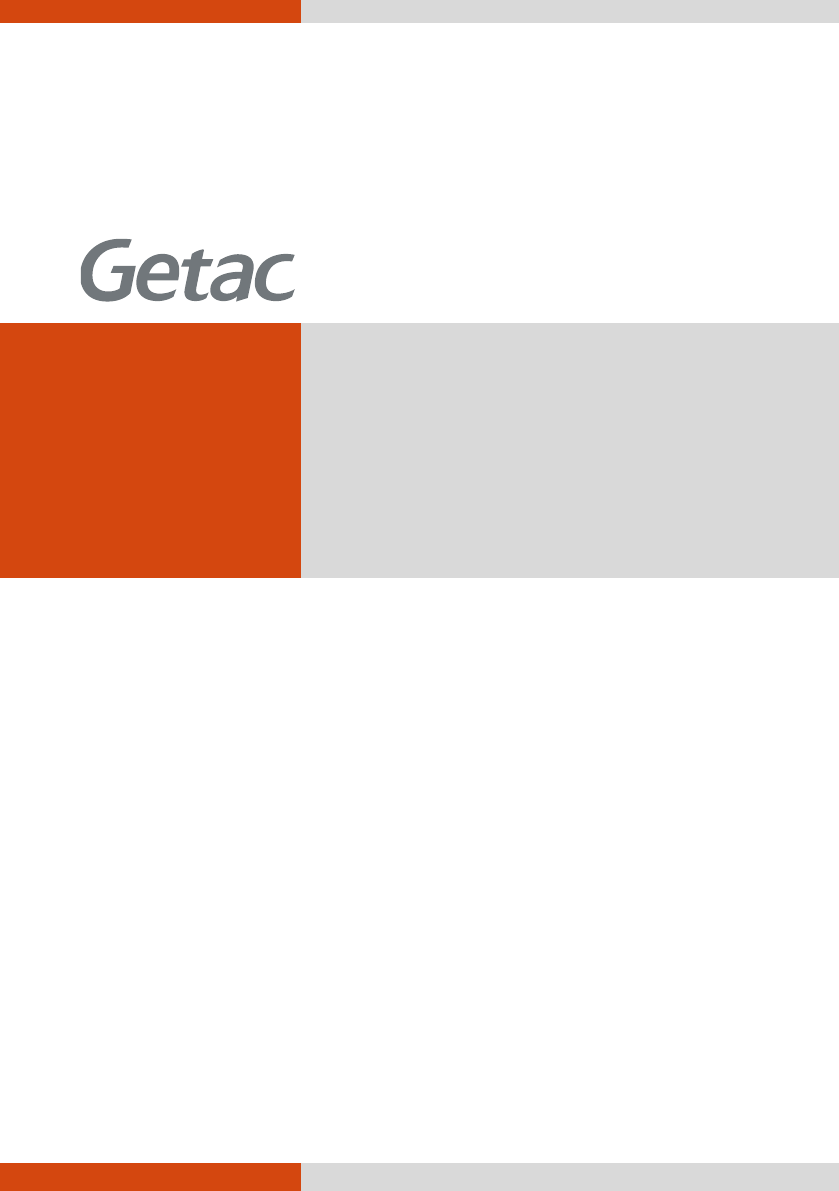
Rugged Mobile Computing Solutions
RX10
USER MANUAL

i
Table of Contents
Chapter 1 Getting Started .......................................................................... 1
Getting the Tablet PC Running .......................................... 2
Unpacking .................................................................. 2
Installing the Micro-SIM Card (Optional) and Battery Pack. 3
Connecting to AC Power ............................................... 5
Using the Tether ......................................................... 6
Taking a Look at the Tablet PC ........................................ 8
Front Components ........................................................ 8
Rear Components ....................................................... 11
Left-Side Components .................................................. 12
Top Components ......................................................... 13
Bottom Components ..................................................... 13
Chapter 2 Operating Your Tablet PC...................................................... 15
Turning On and Off the Tablet PC ................................... 16
Turning On ................................................................ 16
Turning Off ................................................................ 16
Navigating on the Screen................................................. 18
Using the Touchscreen ................................................. 18
Using the Dual Mode Display (Optional) ....................... 20
Using the Wireless Connection Features ............................. 22
Using the WLAN ....................................................... 22
Using the BT Feature ................................................. 23
Using the WWAN Feature (Optional) ........................... 25
Chapter 3 Managing Power ...................................................................... 27
AC Adapter .................................................................. 28
Battery Pack ................................................................ 29
Charging the Battery Pack ........................................... 29

ii
Initializing the Battery Pack .......................................... 30
Checking the Battery Level .......................................... 30
Battery Low Signals and Actions .................................... 31
Replacing the Battery Pack .......................................... 32
Hot Swapping the Battery Pack .................................... 34
Power-Saving Tips ........................................................ 37
Chapter 4 Using Options and Peripherals .............................................. 38
Using the Fingerprint Scanner (Optional) .......................... 39
Enrolling a Fingerprint ................................................. 40
Fingerprint Logon ........................................................ 41
Cleaning the Fingerprint Scanner ................................... 42
Using the NFC/RFID Reader (Optional) ........................... 43
Using the Barcode Scanner (Optional) ............................. 44
Connecting Peripheral Devices .......................................... 45
Connecting a USB Device ........................................... 45
Connecting an Audio Device ........................................ 46
Connecting an HDMI Display Monitor ............................. 46
Chapter 5 Using BIOS Setup .................................................................... 47
When and How to Use .................................................. 48
Menu Descriptions ......................................................... 50
Information Menu ....................................................... 50
Main Menu ............................................................... 50
Advanced Menu .......................................................... 51
Security Menu ........................................................... 52
Boot Menu ............................................................... 53
Exit Menu ................................................................ 53
Chapter 6 Using Getac Software ............................................................. 55
OSD Control Panel ........................................................ 56
G-Manager .................................................................. 57
Getac Camera .............................................................. 59
Chapter 7 Caring for the Tablet PC ........................................................ 60
Taking Care of the Tablet PC .......................................... 61
Location Guidelines ...................................................... 61
General Guidelines ...................................................... 61

iii
Cleaning Guidelines .................................................... 62
Battery Pack Guidelines .............................................. 62
Touchscreen Guidelines ............................................... 64
When Traveling ............................................................. 65
Chapter 8 Troubleshooting ...................................................................... 66
Preliminary Checklist ....................................................... 67
Solving Common Problems .............................................. 68
Battery Problems ........................................................ 68
BT Wireless Transmission Problems ............................... 68
Display Problems ....................................................... 69
Hardware Device Problems .......................................... 69
Power Management Problems ....................................... 70
Sensor Problems (for Windows 10 Models Only)............ 70
Software Problems ...................................................... 71
Sound Problems ........................................................ 72
Startup Problems ....................................................... 72
WLAN Problems ........................................................ 72
Other Problems ......................................................... 74
Resetting the Tablet PC ................................................. 75
System Recovery ........................................................... 76
System Recovery (a Tool for Windows 7 Models) ......... 76
Using the Driver Disc .................................................... 78
Appendix A Specifications .......................................................................... 79
Appendix B Regulatory Information ........................................................... 82
On the Use of the System ............................................. 83
Class B Regulations ................................................... 83
ANSI Warning ........................................................... 84
Safety Notices ........................................................... 85
On the Use of the RF Device ........................................ 88
USA and Canada Safety Requirements and Notices.......... 88
European Union CE Marking and Compliance Notices ....... 89
User Notification of Take-back Service ............................... 91
ENERGY STAR ............................................................ 92
Battery Recycling ........................................................... 94

iv

1
Chapter 1
Getting Started
Congratulations on purchasing this healthcare Tablet PC.
This chapter first tells you step by step how to get the Tablet PC up and running.
Then, you will find a section briefly introducing the external components of the Tablet
PC.
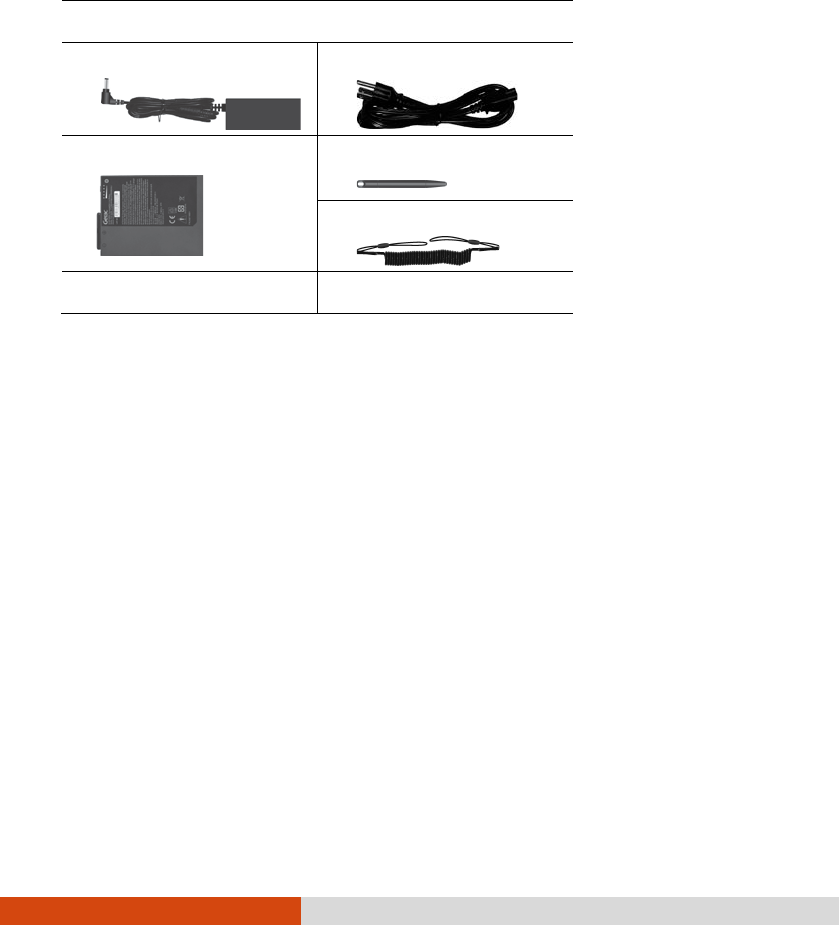
2
Getting the Tablet PC Running
Unpacking
After unpacking the shipping carton, you should find these standard items:
RX10 Tablet PC
AC adapter
AC power cord
Battery pack
Stylus
Tether
Driver disc Document(s)
Inspect all the items. If any item is damage or missing, notify your dealer immediately.
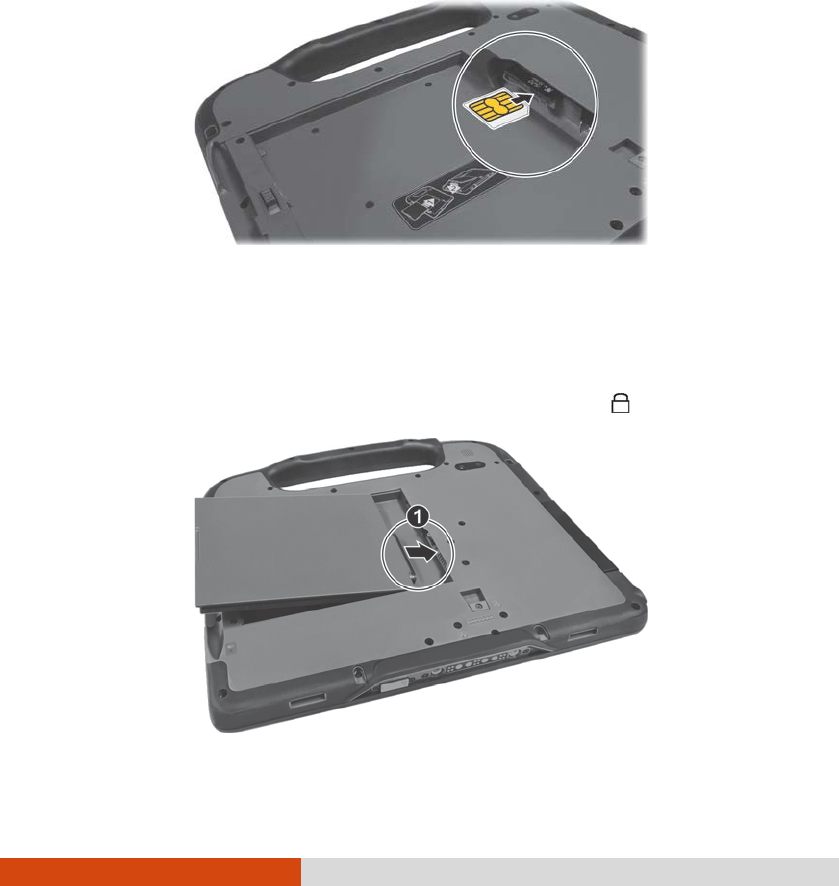
3
Installing the Micro-SIM Card (Optional) and
Battery Pack
1. Select models only:
With the micro-SIM card’s chip side facing up and the beveled corner pointing
to the slot, insert the card all the way into the slot.
NOTE: To remove the micro-SIM card, just push in the card to
pop-out and remove the card.
2. With the battery pack correctly oriented, attach its connector side to the battery
compartment at an angle () and then press down the other side (). The
battery latch should be engaged in the locked position ( ).
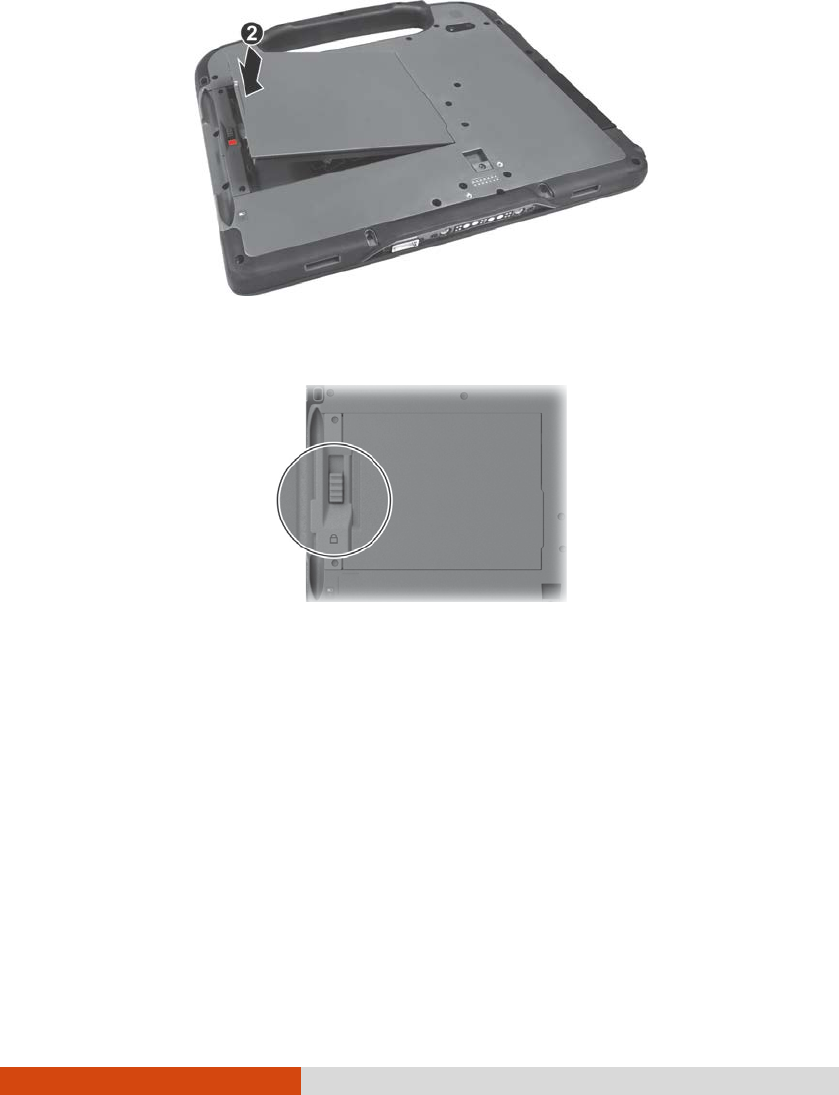
4
CAUTION: Make sure the latch is correctly locked, not revealing
the underneath red part.
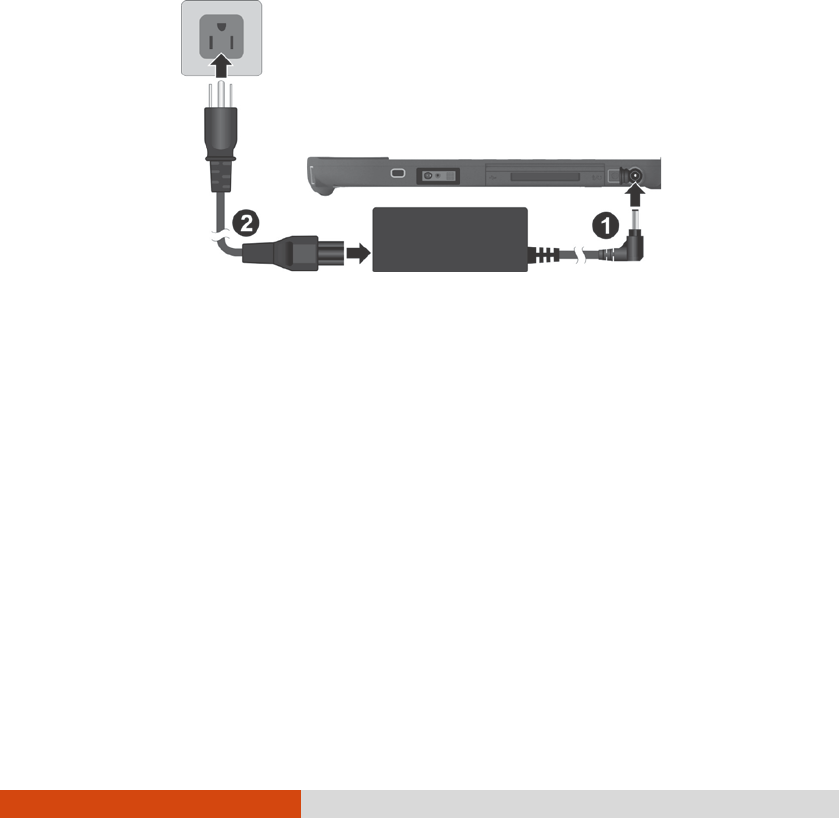
5
Connecting to AC Power
It is suggested that you use AC power when starting up the Tablet PC for the
very first time.
1. Plug the DC cord of the AC adapter to the power connector of the Tablet PC
().
2. Plug the female end of the AC power cord to the AC adapter and the male
end to an electrical outlet ().
3. Power is being supplied from the electrical outlet to the AC adapter and onto
your Tablet PC. Now, you are ready to turn on the Tablet PC.
CAUTION: Use only the AC adapter included with your Tablet PC.
Using other AC adapters may damage the Tablet PC.
NOTE: When the AC adapter is connected, it also charges the
battery pack. For information on using battery power, see
Chapter 3.
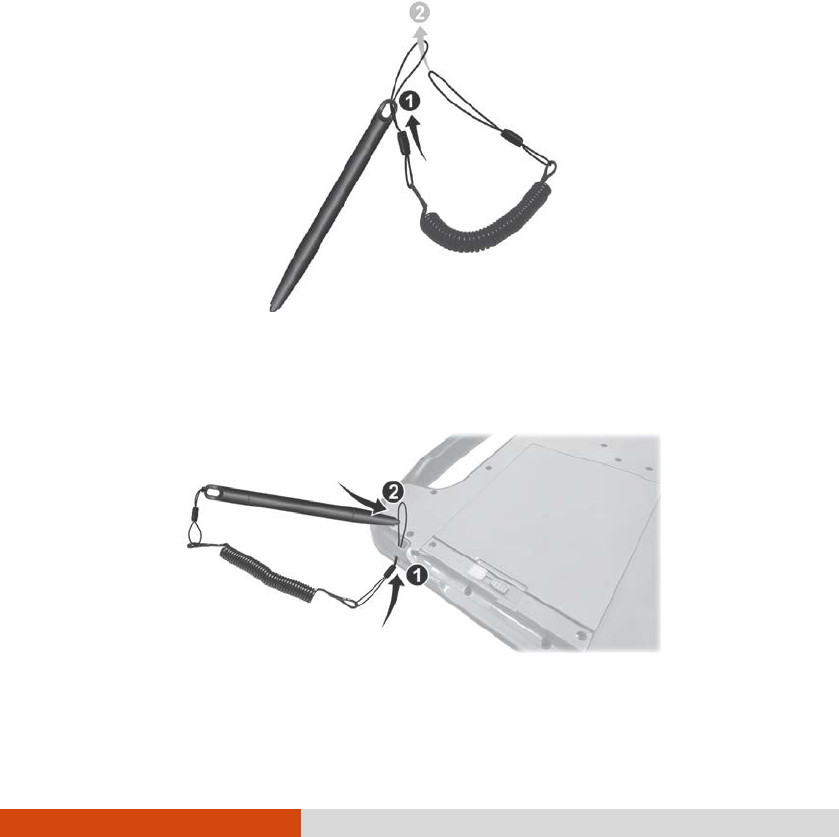
6
Using the Tether
A tether is provided for attaching the stylus to your Tablet PC.
1. Insert one of the tether’s loop ends through the hole of the stylus (as indicated
by below). Then, insert the other end through the first loop (as indicated
by below) and pull it tight.
2. Insert the other loop end to the tether hole on the Tablet PC (as indicated
by below). Then, insert the stylus end through the loop (as indicated by
below) and pull it tight.

7
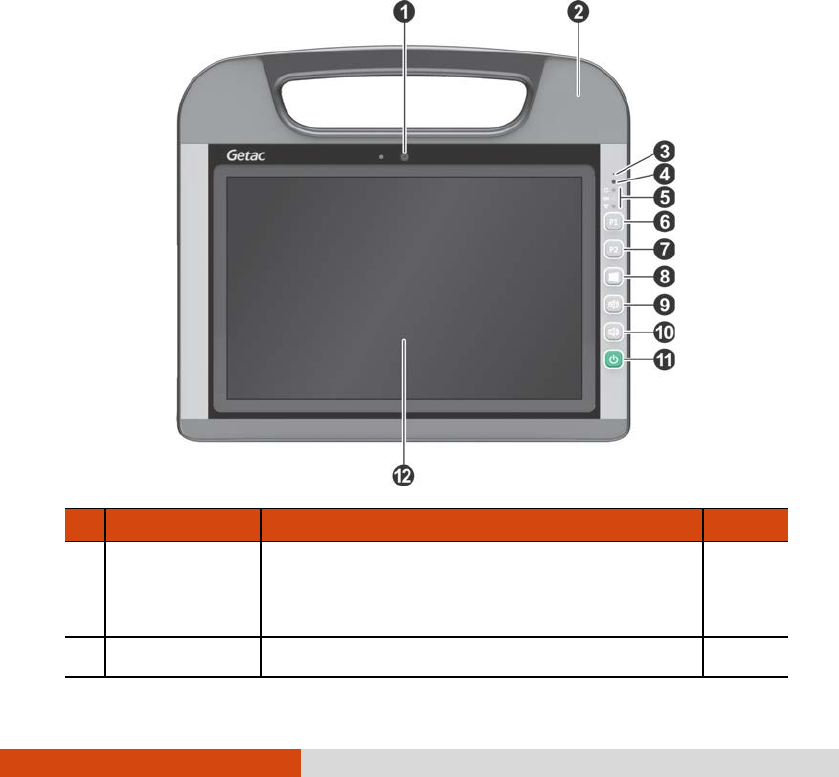
8
Taking a Look at the Tablet PC
NOTE: Depending on the specific model you purchased, the color
and look of your model may not exactly match the graphics shown
in this document.
CAUTION: You need to open the protective covers to access the
connectors. When not using a connector, make sure to close the
cover completely for water- , dust-, and fire-proof integrity.
(Engage the locking mechanism if existing.)
Front Components
Ref
Component
Description
See Also
Camera Lens
Allows you to use the camera function.
When the
camera lens is in use, the indicator beside it lights
up.
P. 59
None
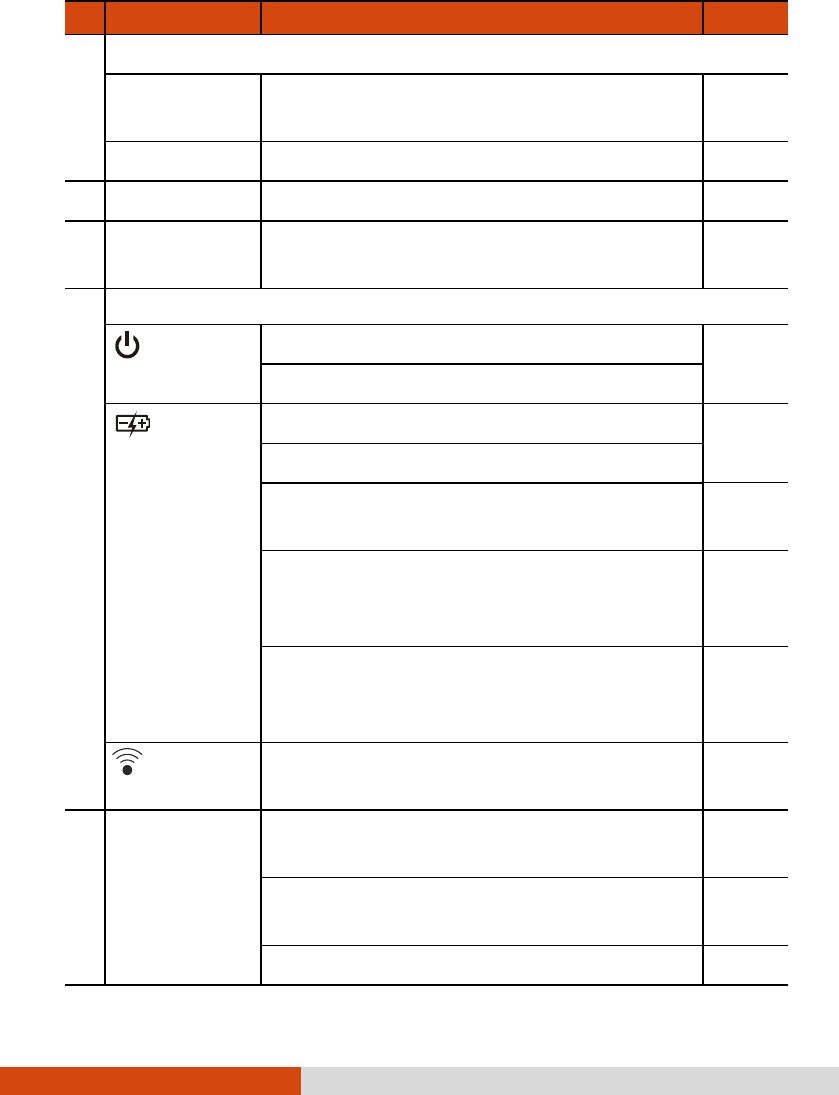
9
Ref
Component
Description
See Also
Or can be one of the below components depending on your model:
Fingerprint
Scanner
Serves as the fingerprint verification, preventing
unauthorized access to your Tablet PC.
P. 39
NFC/RFID Reader
Reads data from NFC devices and RFID tags. P. 43
Microphone
Receives sound and voice.
Light Sensor
Senses the ambient light
for automatic adjustments
of the display backlight.
Indicators
Power Lights blue when the power is on.
Blinks blue when the system is in Sleep mode.
Battery
Charge
Lights green when the battery is fully charged. P. 29
Lights amber when the battery is being charged.
Blinks red (once per second) when the battery’
s
capacity is below 10%.
P. 31
Blinks red rapidly (once per 0.5 second) when
there is a thermal protection problem.
Ask for repair
service in case this happens.
Blinks amber when the battery charging is in an
abnormal state. Replace the battery in case this
happens.
RF (Radio
Frequency)
Lights blue when the RF radio of any RF feature
(WLAN/BT/WWAN) is on.
P1 Button
Starts the Getac
Camera program and serves as
the shutter release button.
P. 59
Can be changed to another set of predefined
functions using G-Manager.
P. 57
Provides a keyboard key function for specific P. 80
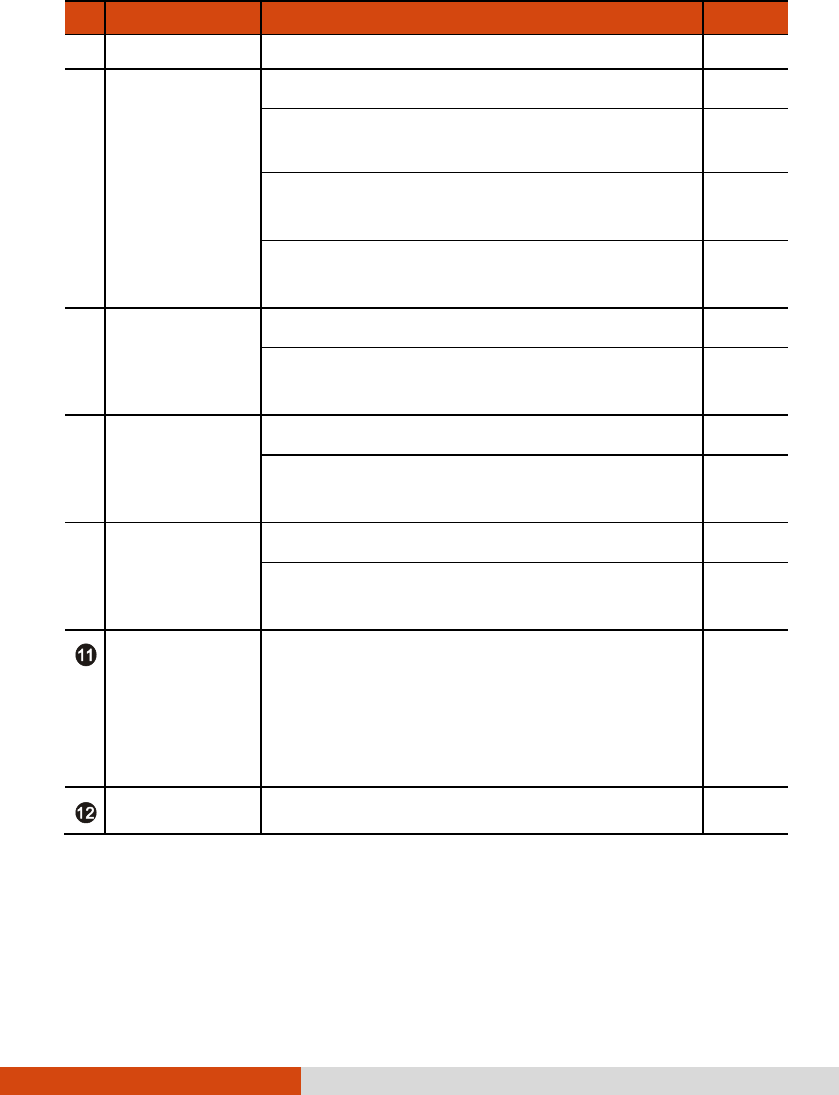
10
Ref
Component
Description
See Also
occasions.
P2 Button
Opens or closes the OSD Control Panel. P. 56
When pressed longer:
Serves as the
Ctrl
+
Alt
+
Del
keyboard keys.
P. 68
Can be changed to another set of predefined
functions using G-Manager.
P. 57
Provides a keyboard key function for specific
occasions.
P. 80
Windows Logo
Button
Opens or closes the Start menu.
Provides a keyboard key function for specific
occasions.
P. 80
Volume Up
Button
Increases the sound volume.
Provides a keyboard key function for specific
occasions.
P. 80
Volume Down
Button
Decreases the sound volume.
Provides a keyboard key function for specific
occasions.
P. 80
Power Button
Turns the power on or off. (The default “off”
state
is “Sleep mode.”)
With a default setting of 2-
second delay, you have
to press the button for at
least 2 seconds for it
to function.
P. 16
Touchscreen
Displays and receives information for the Tablet PC.
P. 18
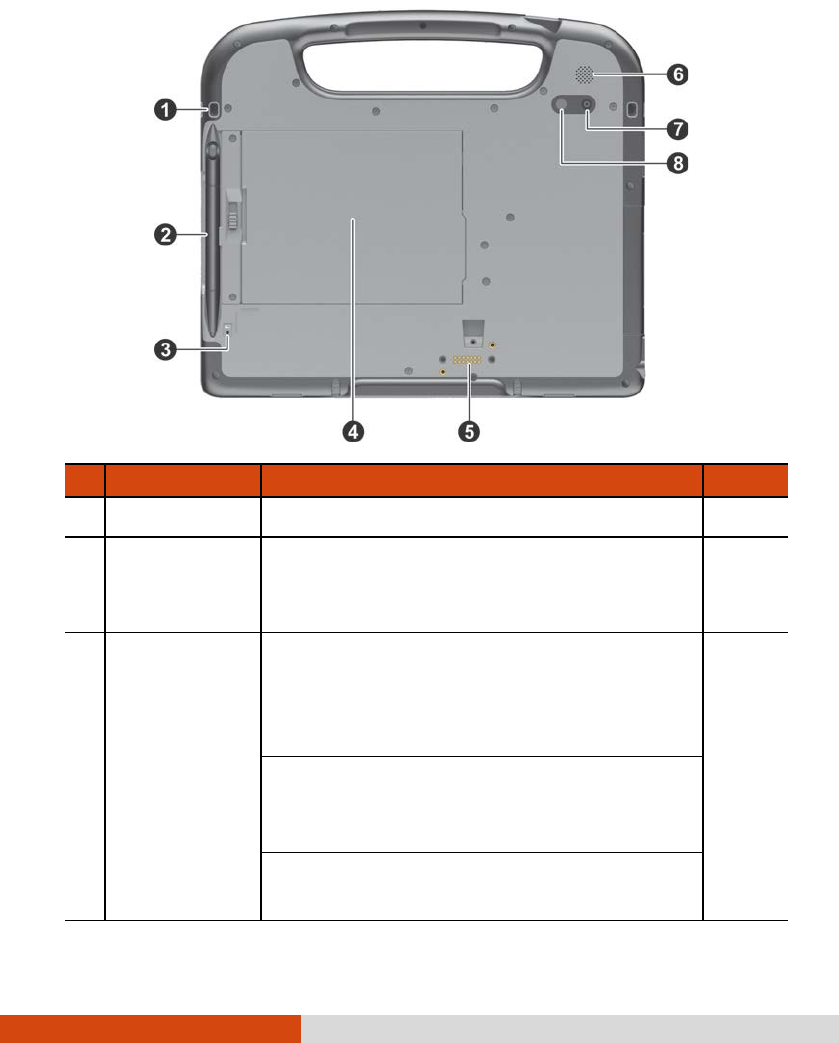
11
Rear Components
Ref
Component
Description
See Also
Tether Hole
Stylus can be tethered to this hole. P. 6
Stylus/
Digitizer Pen
Serves as the input device by tapping on the
touchscreen to make selections and enter
information.
P. 16
Bridge Battery
Indicator
Lights up if you unlock the battery latch while
operating the compute on battery power. The
indicator is intended to inform whether you can
safely hot swap the battery pack.
P. 34
Green light: The bridge battery
can sustain power
for up to 1 minute, during which you can hot swap
the battery pack.
Red light: The bridge battery
level is too low for you
to safely hot swap the battery pack.
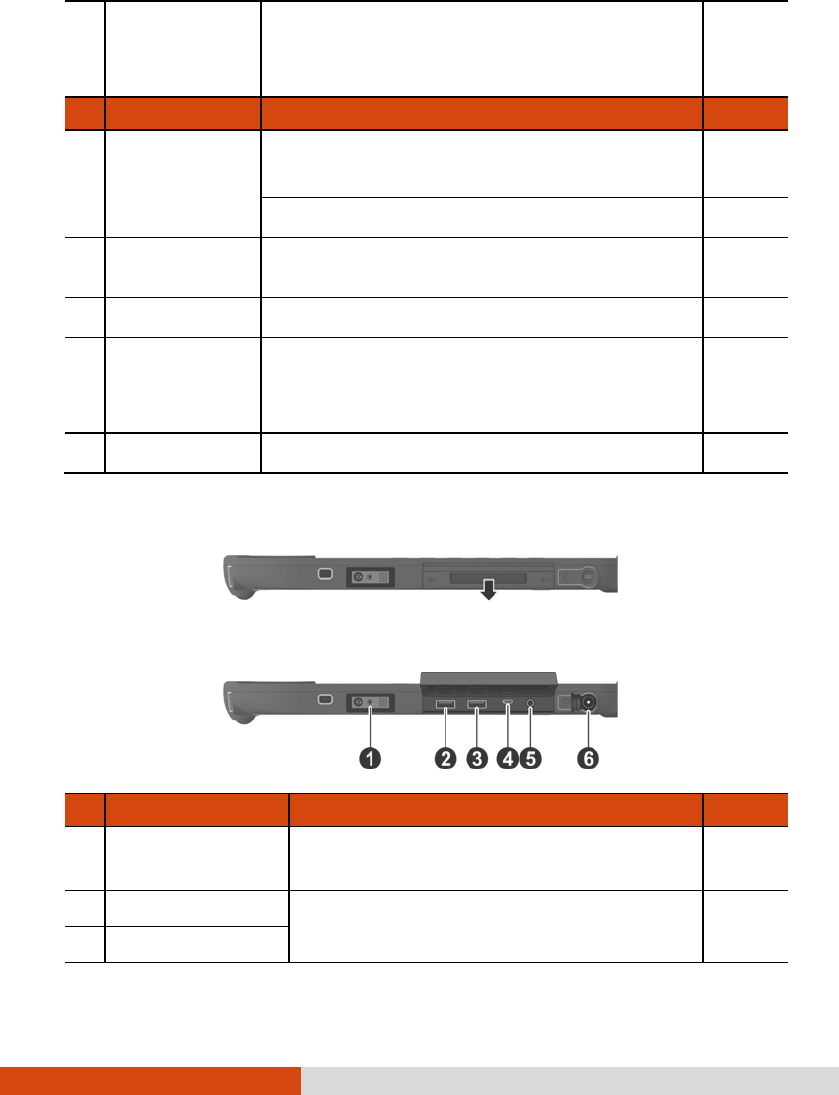
12
Blinking in amber: The bridge battery
charging is in
an abnormal state. Ask for repair service in case
this happens.
Ref
Component
Description
See Also
Battery Pack
Supplies power to
your Tablet PC when external
power is not connected.
P. 29
Inside is the micro-SIM card slot (optional). P. 3
Expansion
Connector
Reserved.
Speaker
Sends out sound and voice from your Tablet PC.
Camera Lens
Allows you to use the camera function.
When the
camera lens is in use, the indicator beside it lights
up.
P. 59
Flash
Provides extra light when taking pictures.
Left-Side Components
Ref
Component
Description
See Also
Barcode Scanner
Lens (optional) Emits red light for barcodes scanning. P. 44
USB 2.0 Port
Connects a USB device, such as a USB
flash
disk, printer, digital camera, joystick, and more.
P. 39
USB 3.0 Port
Slide down to open the
protective cover.
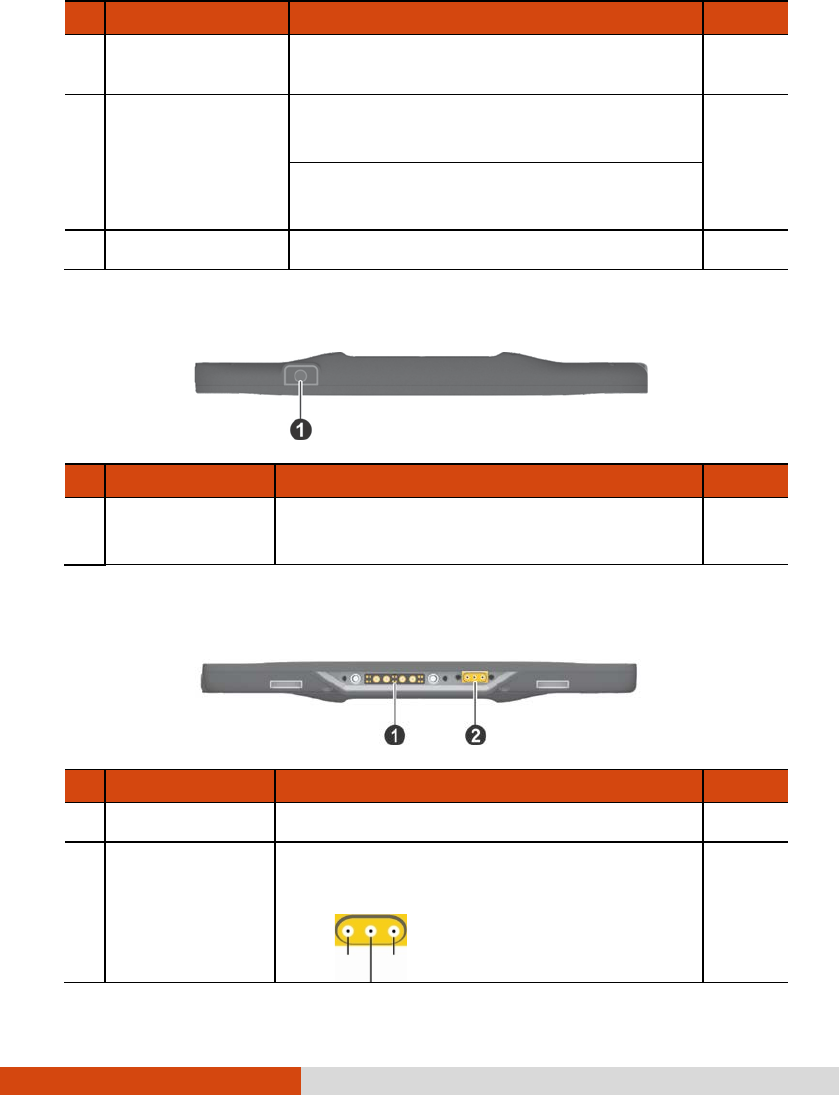
13
Ref
Component
Description
See Also
Micro HDMI
Connector
Connects a HDMI monitor or TV set. P. 46
Combo Audio
Connector
Connects a set of headphones or external
speakers with amplifier
P. 46
Supports a headset microphone with 4-pole
TRRS 3.5mm jack.
Power Connector
Connects the AC adapter. P. 5
Top Components
Ref
Component
Description
See Also
Trigger Button
(optional)
Activates the barcode scanner for single barcode
scanning.
P. 44
Bottom Components
Ref
Component
Description
See Also
Docking Connector
Reserved.
Antenna Pass-
through
(optional)
Co
nnects to the docking station for using external
GPS/WLAN/WWAN antenna.
WWAN
WLAN
GPS

14

15
Chapter 2
Operating Your
Tablet PC
This chapter provides information about the use of the Tablet PC.
If you are new to computers, reading this chapter will help you learn the operating
basics. If you are already a computer user, you may choose to read only the parts
containing information unique to your Tablet PC.
CAUTION:
Do not expose your skin to the Tablet PC when operating it
in a very hot or cold environment.
The Tablet PC can get uncomfortably warm when you use it in
high temperatures. As a safety precaution in such a
circumstance, do not place the Tablet PC on your lap or touch
it with your bare hands for extended periods of time.
Prolonged body contact can cause discomfort and potentially
a burn.
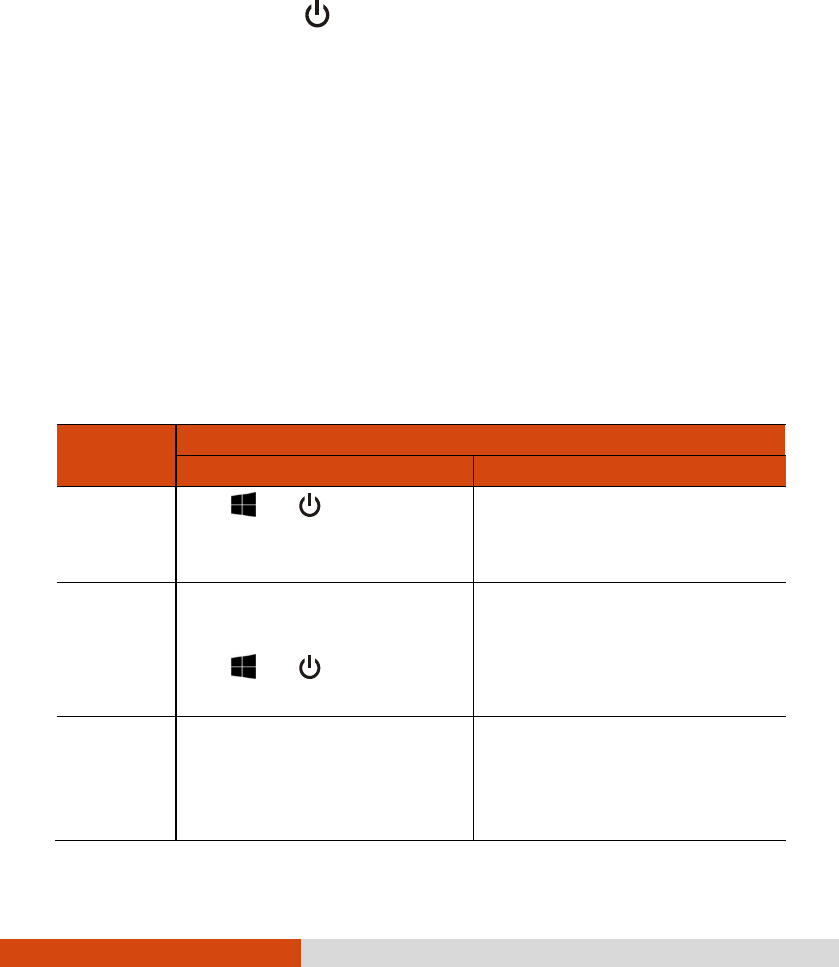
16
Turning On and Off the Tablet PC
Turning On
Press the power button (
) for at least 2 seconds until the Power Indicator
lights up. The Windows operating system should start.
NOTE:
By default, there is 2-second delay time for the power
button. You can change the setting with the “
Power Button Delay
”
item in the BIOS Setup Utility. (See “Advanced Menu” in
Chapter 5.)
Tapping the screen during startup may invoke a pre-boot menu
(unless the default settings have been changed). If the menu
appears, simply select Continue.
Turning Off
When you finish a working session, you can stop the system by turning off the
power or leaving it in Sleep or Hibernation mode:
To...
Do this...
Windows 10
Windows 7
Power off
(Shutdown)
Tap Power Shut
down.
Use the Windows Start menu in the
lower left and follow the shutdown
procedure.
Sleep Press the power button.*
-or-
Tap Power
Sleep.
Press the power button.*
-or-
Use the Windows Start menu to put
the Tablet PC in Sleep mode.
Hibernate By default, this option is not shown
in the Start
menu. If you want to
use the feature, set up
accordingly in Windows settings.
Use the Windows Start menu to put
the Tablet PC in Hibernation mode.

17
* “Sleep” is the default setting of the power button. You may change what the
power button does in Windows settings.
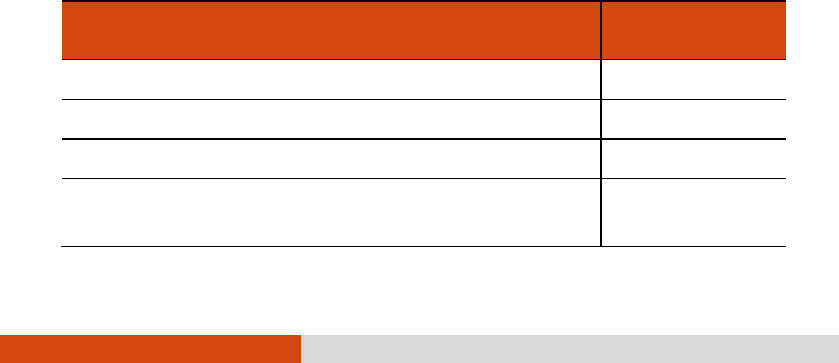
18
Navigating on the Screen
The screen of your Tablet PC is touch-sensitive. You can control the location of
the cursor/pointer on the screen using the included stylus or your finger to
communicate with the Tablet PC.
CAUTION: Do not use a sharp object such as a ballpoint pen or
pencil on the touchscreen. Doing so may damage the touchscreen
surface. Use the included stylus or your finger.
NOTE: An optical film has been attached to the screen before
shipment. The film is a consumable, which will be worn out by
possible scratches. You can purchase a new one when replacement
is required.
Using the Touchscreen
Your Tablet PC has a capacitive touchscreen. This type of touchscreen responds
to objects that have conductive properties, such as fingertips and a capacitive-tipped
stylus.
By default settings, your touchscreen responds best to fingertips. If you prefer using
a capacitive-tipped stylus (such as the one supplied with your model) or if you
are wearing gloves, you should change the touchscreen settings to suit your scenario.
(Use the G-Manager program and select the Touch Screen tab to set up.)
The following table shows how you use the touchscreen to obtain equivalent mouse
functions.
Term/Action
Equivalent Mouse
Function
Tap: Touch the screen once. Click/Point
Double-tap: Touch the screen twice rapidly. Double-click
Tap and hold: Tap and hold until a popup menu appears. Right-click
Drag: Hold the stylus (or finger)
on the screen and drag across
the screen until reaching your destination.
Drag
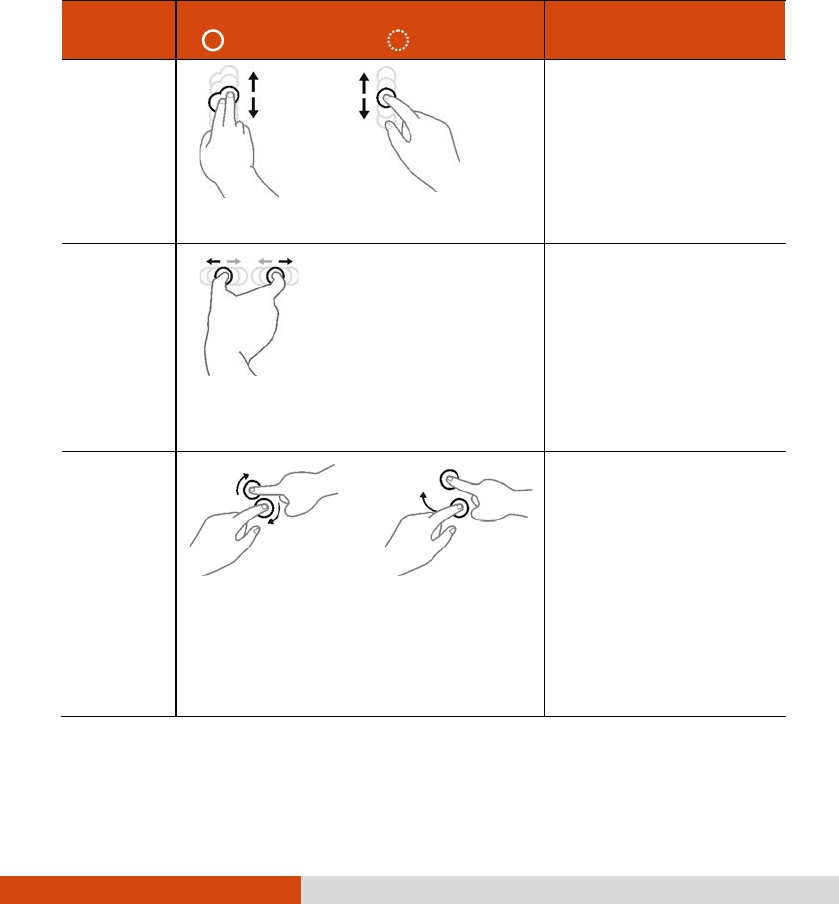
19
Using Multi-touch Gestures
You can interact with your Tablet PC by placing two fingers on the screen. The
movement of the fingers across the screen creates “gestures,” which send commands
to the Tablet PC.
Here are the multi-touch gestures that you can use:
Gestures
Actions
( = finger down; = finger up)
Descriptions
Pan
(Scroll)
or
Drag 1 or 2 fingers up or down.
Use panning to see
another part of a page that
has scroll bars.
Zoom
(Pinch)
Move two fingers apart/toward each
other.
Use zooming to make an
item (a photo for
example) on the screen
larger or smaller. The
gesture works in
applications that support
mouse wheel zooming.
Rotate
or
Move two fingers in opposing directions.
-or-
Use one finger to pivot around another.
Use rotating to move a
picture or other item on
the screen in a circular
direction (clockwise or
counter-
clockwise). The gesture
works in applications that
support the specific
gesture.
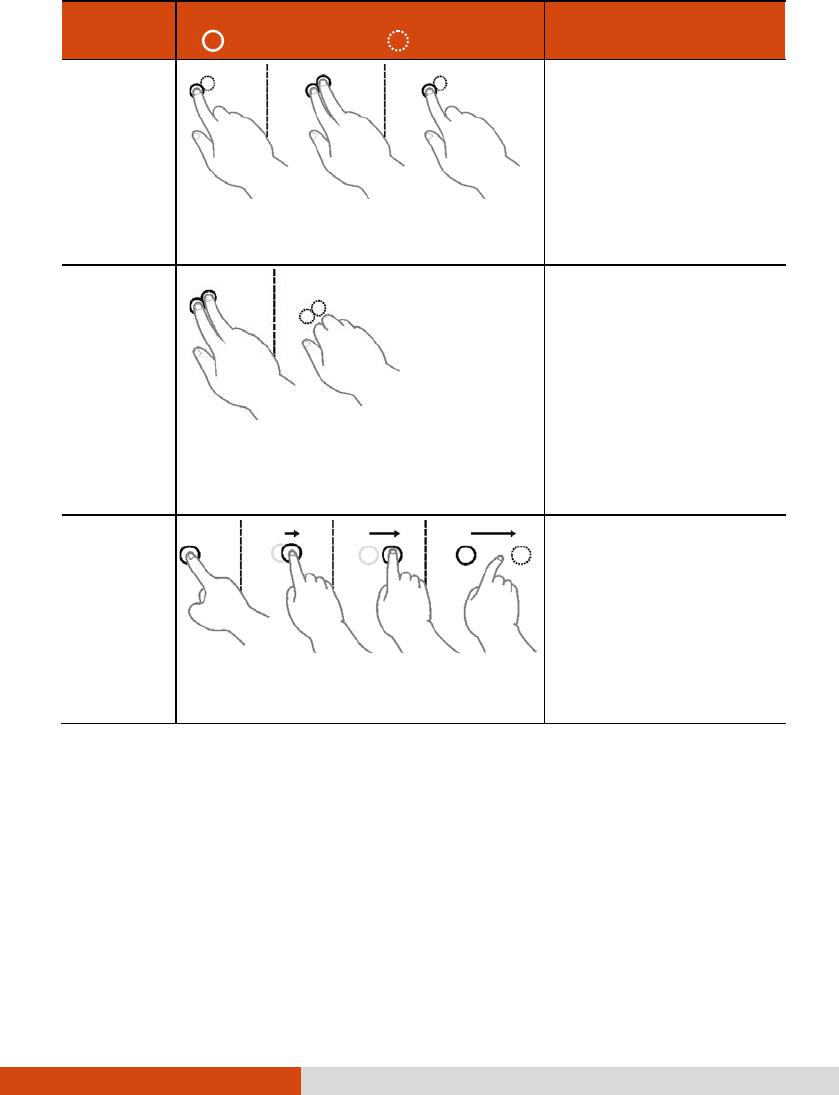
20
Gestures
Actions
( = finger down; = finger up)
Descriptions
Press and
Tap
Press on target and tap using a second
finger.
Use press and tap to
access the shortcut
menu.
Two-
finger Tap
Tap two fingers at the same time (where
the target is in the midpoint between the
fingers).
The function is defined by
applications that support
the specific gesture.
Flicks
Make quick drag gestures in the desired
direction.
Flick left or right to
navigate back and forward
in a browser and other
applications. The gesture
works in most applications
that support back and
forward.
Using the Dual Mode Display (Optional)
Dual mode display (if your model has the feature) incorporates both touchscreen
and digitizer functions.
The display is set to Touchscreen mode by default. Touchscreen mode provides
all the functionalities that an ordinary touchscreen has. When the Tablet PC receives
signals from the digitizer pen, the display automatically switches to Digitizer mode.

21
You can move the cursor by bringing the digitizer pen close to the screen, without
actually touching the screen’s surface.
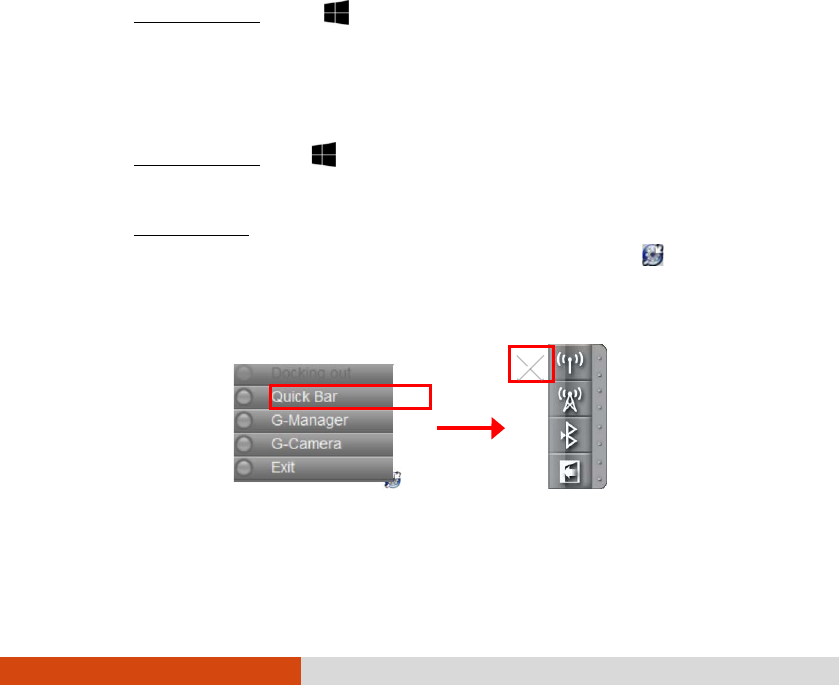
22
Using the Wireless Connection Features
Using the WLAN
The WLAN (Wireless Local Area Network) module supports IEEE 802.11ac,
compatible with 802.11a/b/g/n.
Turning On/Off the WLAN Radio
To turn on the WLAN radio:
1. Make sure that the Airplane mode is switched off. You can control the Airplane
mode using one of the below methods.
• Use the Airplane Mode button in the OSD Control Panel.
• For Windows 10: Tap Settings Network & Internet Airplane
mode. Slide the Airplane mode switch to the Off position.
2. If you have previously turned off the WLAN radio, use one of the below methods
to turn it on.
• For Windows 10: Tap Settings Network & Internet Wi-Fi. Slide
the Wi-Fi switch to the On position.
• For Windows 7: Use either Windows Mobility Center or Getac Quick Bar. To
open Getac Quick Bar, tap and hold the Getac Utility icon on Windows
taskbar and select
Quick Bar
. Tap the WLAN button in the Quick Bar (an
X over the button means the radio is currently off).
To turn off the WLAN radio:
You can turn off the WLAN radio the same way you turn it on.

23
If you want to quickly turn off all wireless radio, simply switch on Airplane mode.
Connecting to a WLAN Network
1. Make sure that the WLAN function is enabled (as described above).
2.
For Windows 10:
Tap the network icon in the system tray.
For Windows 7:
Tap the Wireless Network icon on the taskbar. (An orange
light in the icon indicates connections are available.)
3. In the list of available wireless networks, tap a network, and then tap
Connect
.
4. Some networks require a network security key or passphrase. To connect to
one of those networks, ask your network administrator or Internet service provider
(ISP) for the security key or passphrase.
For more information on setting a wireless network connection, refer to Windows
online help.
NOTE: You can use Intel® PROSet Wireless to take full advantage
of the Wi-Fi capabilities. See the Help of the utility for
instructions.
Using the BT Feature
The BT technology allows short-range wireless communications between devices
without requiring a cable connection. Data can be transmitted through walls, pockets
and briefcases as long as two devices are within range.
Turning On/Off the BT Radio
To turn on the BT radio:
1. Make sure that the Airplane mode is switched off. You can control the Airplane
mode using one of the below methods.
• Use the Airplane Mode button in the OSD Control Panel.
• For Windows 10: Tap Settings Network & Internet Airplane
mode. Slide the Airplane mode switch to the Off position.

24
2. If you have previously turned off the BT radio, use one of the below methods
to turn it on.
• For Windows 10: Tap Settings Devices Bluetooth. Slide the BT
switch to the On position.
•
For Windows 7:
Use Getac Quick Bar. To open Getac Quick Bar, tap and
hold the Getac Utility icon on Windows taskbar and select
Quick Bar
.
Tap the BT button in the Quick Bar (an X over the button means the
radio is currently off).
To turn off the BT radio:
You can turn off the BT radio the same way you turn it on.
If you want to quickly turn off all wireless radio, simply switch on Airplane mode.
Connecting to another BT Device
1. Make sure that the BT function is enabled (as described above).
2. Make sure that the target BT device is turned on, discoverable and within close
range. (See the documentation that came with the BT device.)
3.
For Windows 10:
Tap Settings Devices Bluetooth.
For Windows 7:
Tap and hold the BT icon on Windows taskbar. Tap Add a Device.
4. Select the device you want to connect from the search results.
5. Depending on the type of BT device that you want to connect to, you will need
to enter the pertinent information.
For detailed information on using the BT feature, see Windows’ online Help.
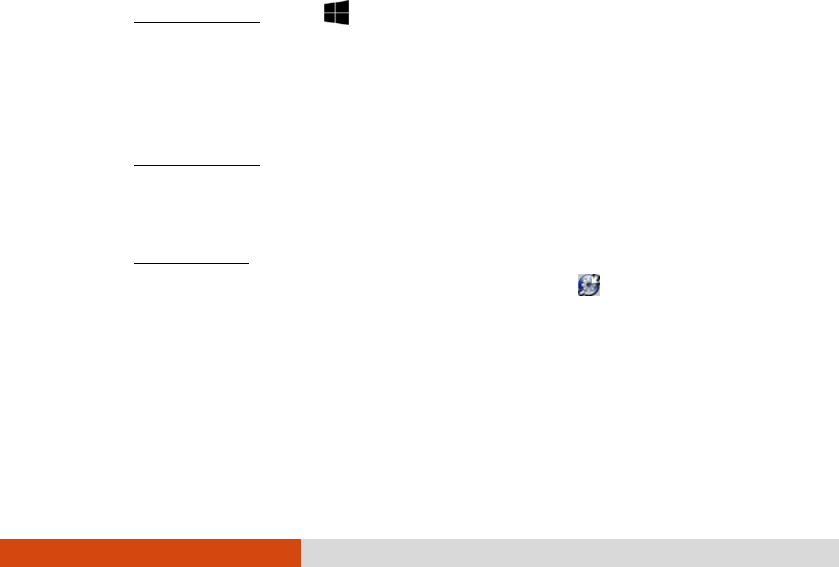
25
Using the WWAN Feature (Optional)
A WWAN (Wireless Wide Area Network) uses mobile telecommunication cellular
network technologies to transfer data. The WWAN module of your Tablet PC supports
3G and 4G LTE.
NOTE:
Your model only supports data transmission. Voice
transmission is not supported.
For instructions on installing the micro-SIM card, see
“Installing the Micro-SIM Card (Optional) and Battery Pack”
in Chapter 1.
Turning On/Off the WWAN Radio
To turn on the WWAN radio:
1. Make sure that the Airplane mode is switched off. You can control the Airplane
mode using one of the below methods.
• Use the Airplane Mode button in the OSD Control Panel.
• For Windows 10: Tap Settings Network & Internet Airplane
mode. Slide the Airplane mode switch to the Off position.
2. If you have previously turned off the WWAN radio, use one of the below methods
to turn it on.
• For Windows 10: Open the Charms Bar of Windows. Tap Settings
Network & Internet Mobile Broadband. Slide the Mobile Broadband switch
to the On position.
• For Windows 7: Use the WWAN utility software or Getac Quick Bar. To open
Getac Quick Bar, tap and hold the Getac Utility icon on Windows taskbar
and select
Quick Bar
. Tap the WWAN button in the Quick Bar (an X over
the button means the radio is currently off).
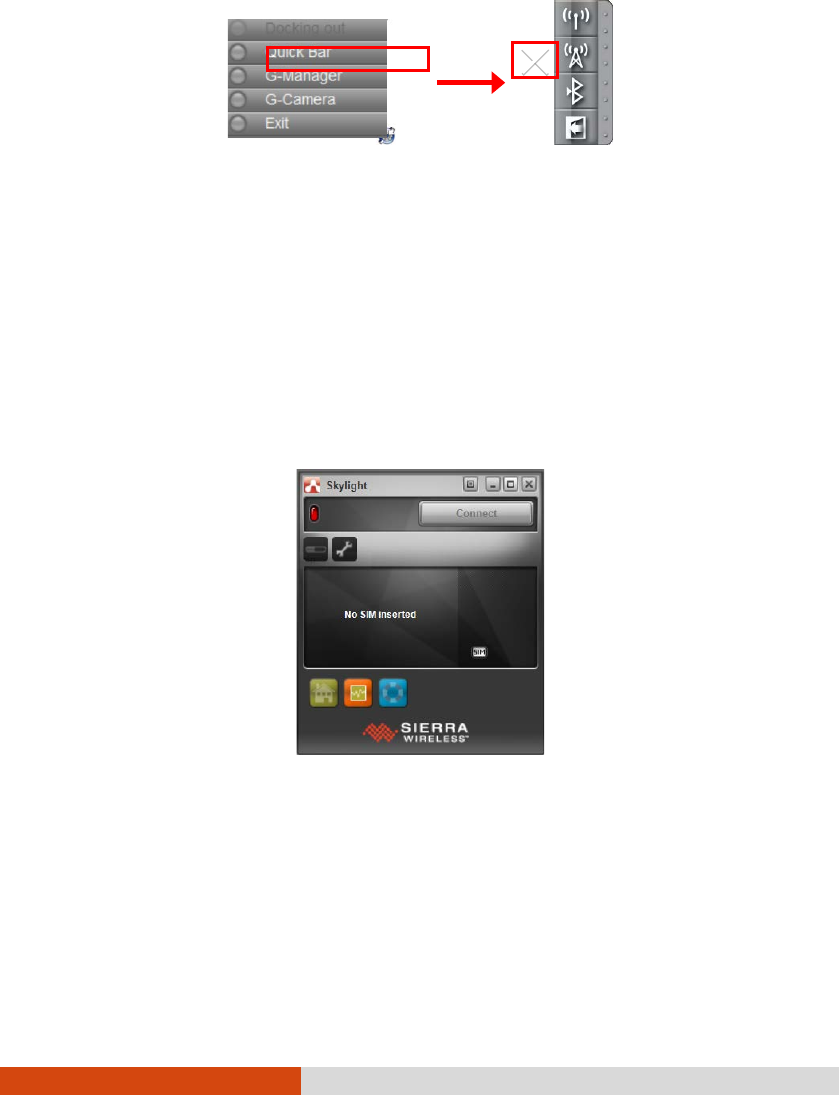
26
To turn off the WWAN radio:
You can turn off the WWAN radio the same way you turn it on.
If you want to quickly turn off all wireless radio, simply switch on Airplane mode.
Setting up a WWAN Connection
1. Make sure that the micro-SIM card is inserted and the WWAN function is enabled
(as described above).
2. Start the WWAN utility software (
Skylight
).
3. You can use the WWAN utility software to configure and use WWAN connections.
See the online help for information.

27
Chapter 3
Managing Power
Your Tablet PC operates either on external AC power or on internal battery power.
This chapter tells you how you can effectively manage power. To maintain optimal
battery performance, it is important that you use the battery in the proper way.

28
AC Adapter
CAUTION:
The AC adapter is designed for use with your Tablet PC only.
Connecting the AC adapter to another device can damage the
adapter.
The AC power cord supplied with your Tablet PC is for use
in the country where you purchased your Tablet PC. If you
plan to go overseas with the Tablet PC, consult your dealer
for the appropriate power cord.
When you disconnect the AC adapter, disconnect from the
electrical outlet first and then from the Tablet PC. A reverse
procedure may damage the AC adapter or Tablet PC.
When unplugging the connector, always hold the plug head.
Never pull on the cord.
The AC adapter serves as a converter from AC (Alternating Current) to DC (Direct
Current) power because your Tablet PC runs on DC power, but an electrical outlet
usually provides AC power. It also charges the battery pack when connected to AC
power.
The adapter operates on any voltage in the range of 100~240 V AC.

29
Battery Pack
The battery pack is the internal power source for the Tablet PC. It is rechargeable
using the AC adapter.
NOTE: Care and maintenance information for the battery is
provided in the “Battery Pack Guidelines” section in Chapter
7.
Charging the Battery Pack
NOTE:
Charging will not start if the battery’s temperature is
outside the allowed range, which is between 0 °C (32 °F) and
50 °C (122 °F). Once the battery’s temperature meets the
requirements, charging automatically resumes.
During charging, do not disconnect the AC adapter before the
battery has been fully charged; otherwise you will get a
prematurely charged battery.
To charge the battery pack, connect the AC adapter to the Tablet PC and an electrical
outlet. The Battery Charge Indicator ( ) on the Tablet PC glows amber to
indicate that charging is in progress. You are advised to keep the Tablet PC power
off while the battery is being charged. When the battery is fully charged, the Battery
Charge Indicator glows green.
It takes approximately 2.5 hours to fully charge the battery pack.
CAUTION: After the Tablet PC has been fully recharged, do not
immediately disconnect and reconnect the AC adapter to charge
it again. Doing so may damage the battery.
NOTE: The battery level may automatically lessen due to the
self-discharge process (0.21% per day), even when the battery
pack is fully charged (100%). This happens no matter if the
battery pack is installed in the Tablet PC.

30
Initializing the Battery Pack
You need to initialize a new battery pack before using it for the first time or when
the actual operating time of a battery pack is much less than expected. Initializing
is the process of fully charging, discharging, and then charging. It can take several
hours.
A software tool called “Gauge Reset” is provided for the purpose. Use the G-Manager
program and select the Battery tab to find the tool.
Checking the Battery Level
NOTE: Any battery level indication is an estimated result. The
actual operating time can be different from the estimated time,
depending on how you are using the Tablet PC.
The operating time of a fully charged battery pack depends on how you are using
the Tablet PC. When your applications often access peripherals, you will experience
a shorter operating time.
By Operating System
You can check the approximate battery level using the battery meter function of the
operating system. To read the battery level in Windows, tap the battery icon on
the taskbar.
By Gas Gauge
On the exterior side of the battery pack is a gas gauge for displaying the estimated
battery charge. When the battery pack is not installed in the Tablet PC and you
want to know the battery charge, you can press the push-button to see the number
of LEDs that light up. Each LED represents 20% charge.
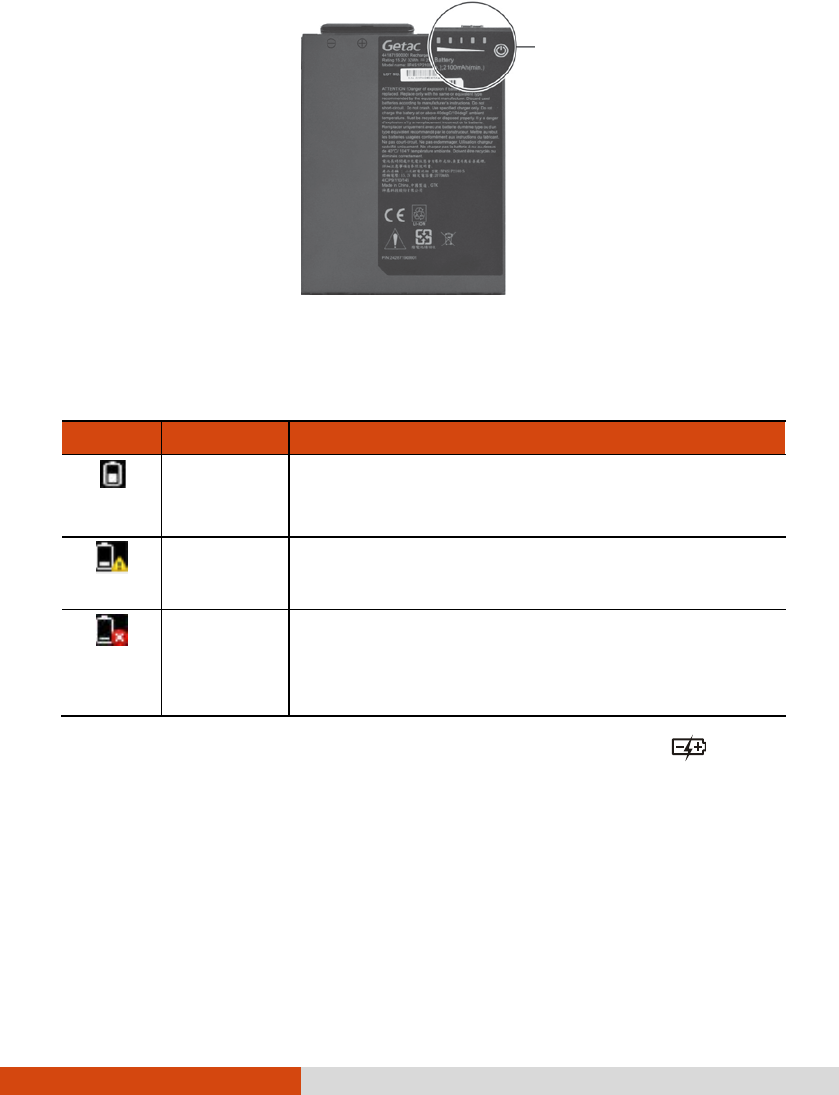
31
Battery Low Signals and Actions
The battery icon changes appearance to display the current state of the battery.
Icon
Battery Level
Description
Discharging The icon shows the charge remaining in 10-percent
increments until the charge reaches the low-battery level.
Low The battery charge has reached the low-
battery level
(10% by default).
Critically low The battery charge has reached the critical battery level
(5% by default). By default, Windows will display a
notification and put your Tablet PC into Hibernation.
When the battery is low, the Tablet PC’s Battery Charge Indicator ( ) also
blinks red to alert you to take actions.
Always respond to low-battery by connecting the AC adapter, placing your Tablet
PC in Hibernation mode, or turning off the Tablet PC.
Push-button
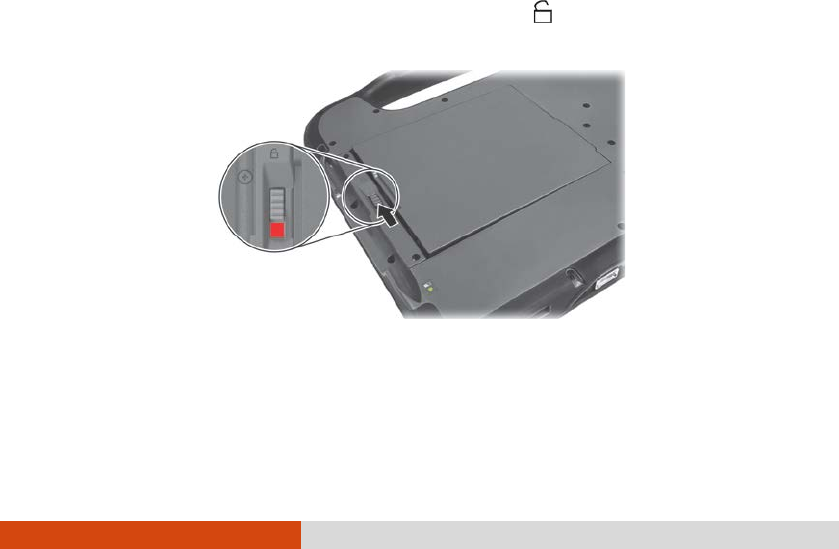
32
Replacing the Battery Pack
CAUTION:
There is danger of explosion if the battery is incorrectly
replaced. Replace the battery only with the Tablet PC
manufacturer’s battery packs. Discard used batteries
according to the dealer’s instructions.
Do not attempt to disassemble the battery pack.
NOTE: You can hot swap the battery pack as described later in
“Hot Swapping the Battery Pack.”
1. Turn off the Tablet PC and disconnect the AC adapter. (Skip this step if you
are hot swapping the battery pack.)
2. Slide the battery latch to the unlocked position ( ). The battery pack will
slightly pop up.
3. Remove the battery pack from its compartment
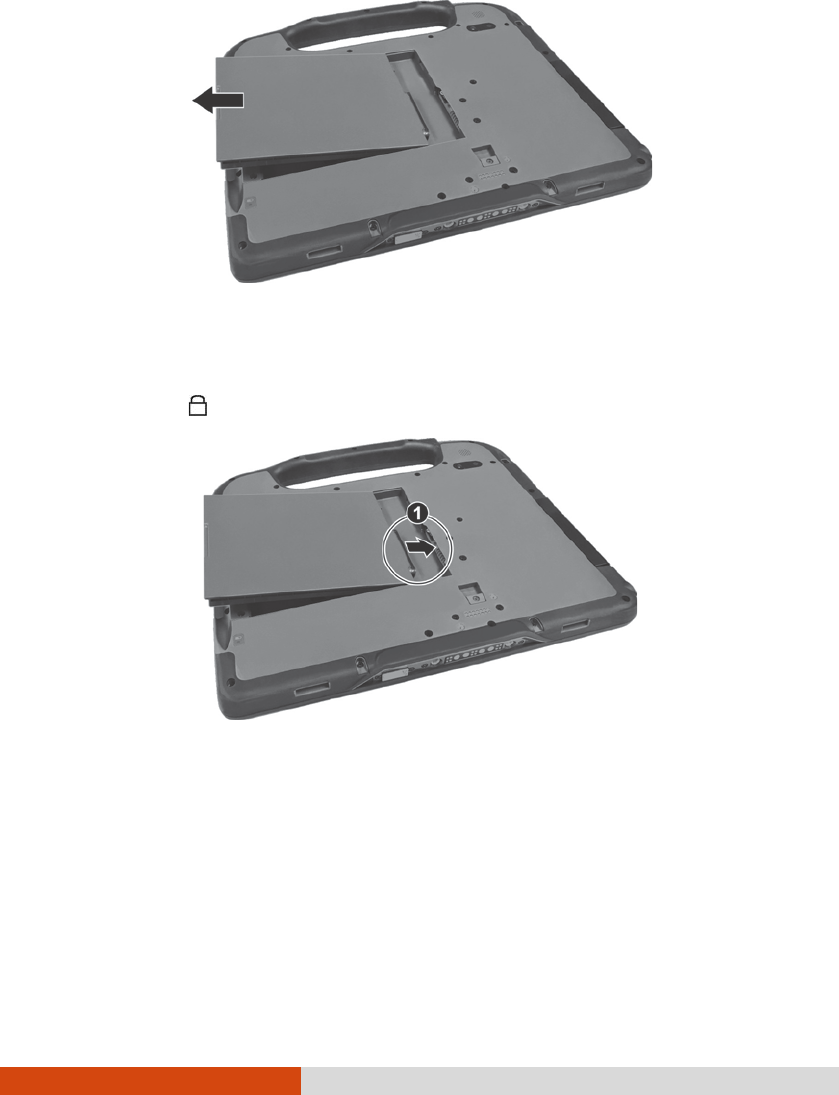
33
4. Fit another battery pack into place. With the battery pack correctly oriented, attach
its connector side to the battery compartment at an angle () and then press
down the other side (). The battery latch should be engaged in the locked
position ( ).
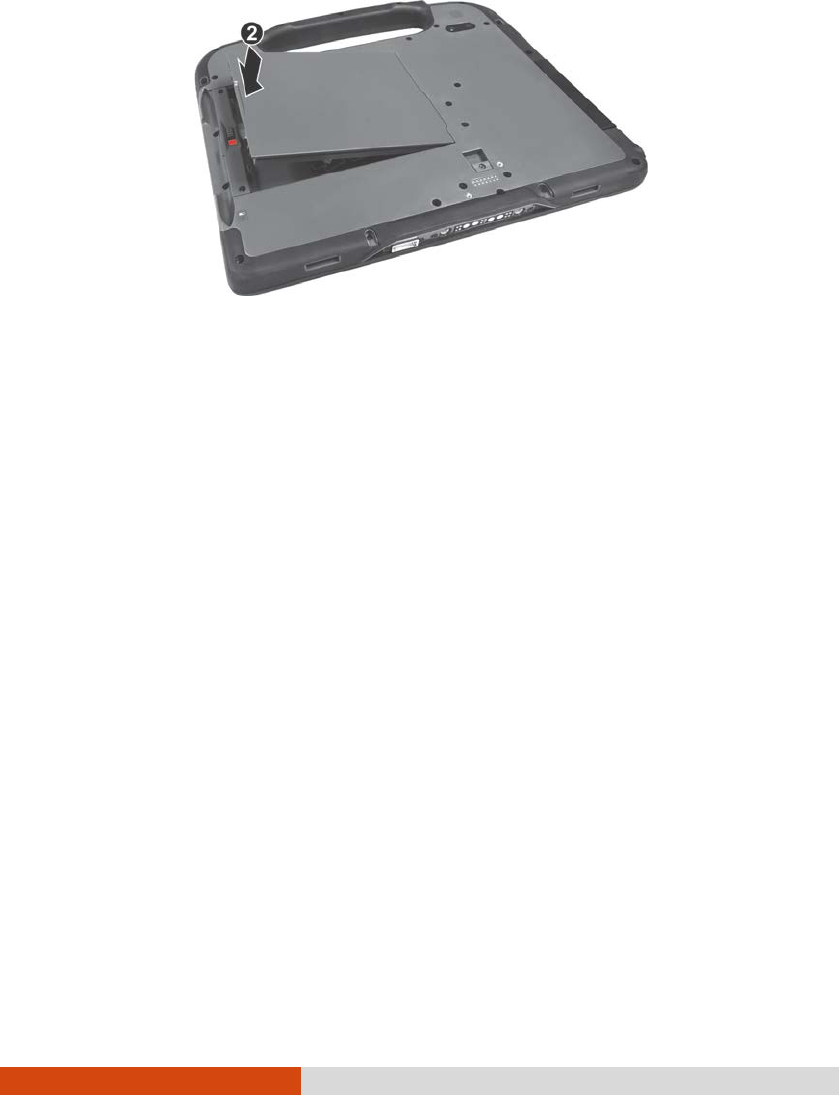
34
CAUTION: Make sure the latch is correctly locked, not revealing
the underneath red part.
Hot Swapping the Battery Pack
“Hot swapping” means you can safely replace the battery pack without shutting down
while your Tablet PC is running on battery power. This is possible because your
Tablet PC has an internal bridge battery. The bridge battery can sustain power for
up to 1 minute, which should be long enough for you to replace the battery pack.
Hints and Reminders
See “Replacing the Battery Pack” for replacement instructions and note the following
hints and reminders on hot swapping:
Make sure you have another charged battery pack.
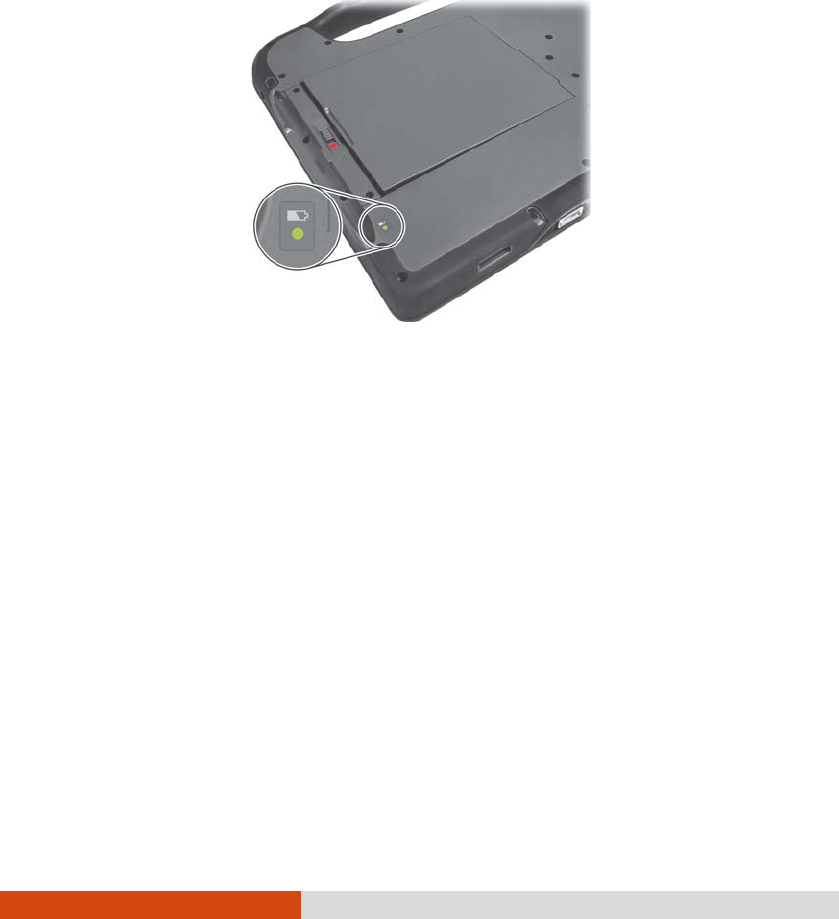
35
The appropriate temperature range for hot swapping the battery pack is between
-10 °C (14 °F) and 50 °C (122 °F).
Check the Bridge Battery Indicator after unlocking the battery latch. Replace the
battery pack only when the indicator lights in green. A red light means the bridge
battery level is too low for you to safely hot swap the battery pack.
When the battery latch is unlocked, the display brightness level will be fixed
at a low level and cannot be adjusted.
If a charged battery pack is not inserted within one minute, the Tablet PC enters
Hibernation mode.
After removing the battery pack, do not connect and immediately disconnect the
AC adapter. This will shut down the Tablet PC.
About the Bridge Battery
The bridge battery is not user-replaceable and is invisible to the operating system.
It never functions as the power source as long as the main battery pack is
installed.
By default, the bridge battery is charged by external AC power (if connected)
or the main battery pack (if external power is not connected). You can limit

37
Power-Saving Tips
Aside from enabling your Tablet PC’s power saving mode, you can do your part
to maximize the battery’s operating time by following these suggestions.
Do not disable Power Management.
Decrease the LCD brightness to the lowest comfortable level.
Shorten the length of time before Windows turn off the display.
When not using a connected device, disconnect it.
Turn off the wireless radio if you are not using the wireless module (such as
WLAN, BT, or WWAN).
Turn off the Tablet PC when you are not using it.

38
Chapter 4
Using Options and
Peripherals
This chapter describes the use of optional modules and the connection of peripherals.
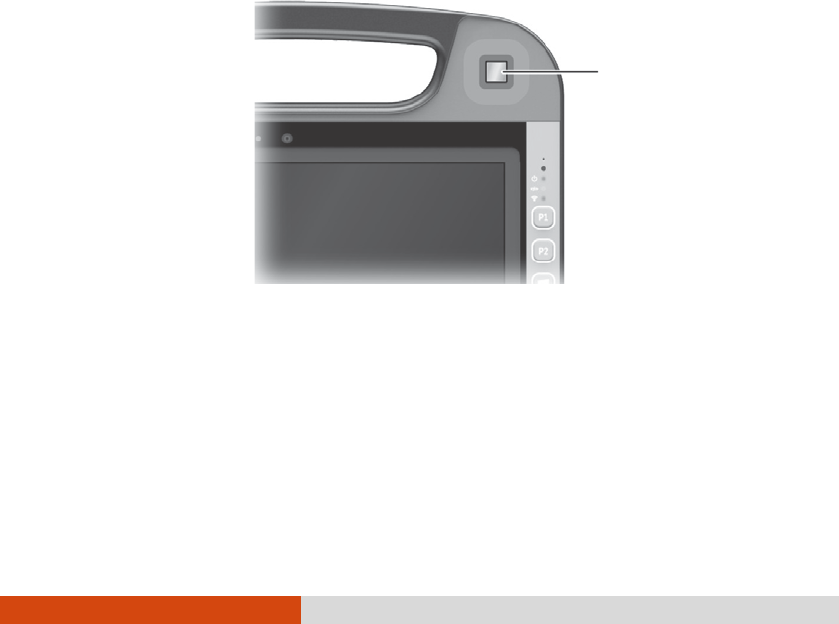
39
Using the Fingerprint Scanner
(Optional)
CAUTION:
For optimal performance, both the scanning surface and the
finger should be clean and dry. Clean the scanning surface
when needed. (See “Cleaning the Fingerprint Scanner” later.)
It is not recommended that you use the fingerprint scanner
in a below-
freezing temperature. The moisture on your finger can freeze
to the scanner’s metal surface when you touch it, resulting
in a failed operation. Besides, touching freezing metal with
your finger can cause frostbite.
The fingerprint scanner (if your model has the feature) provides a strong
authentication mechanism based on fingerprint recognition. You can log on to Windows
and dismiss the lock screen with an enrolled fingerprint instead of a password.
Fingerprint
scanner

40
Enrolling a Fingerprint
NOTE: You can enroll a fingerprint only after creating a
password for the Windows user account.
For Windows 10
1. Tap Settings Accounts Sign-in options.
2. On the right side under Fingerprint, tap Set up.
3. Follow the onscreen instructions to complete.
For Windows 7
1. Log on to Windows as the user whose fingerprint is to be enrolled.
2. Double-tap iMD Fingerprint Reader on Windows desktop.
3. In the fingerprint configuration menu, tap Add another.
4. You will be asked to enter the password of the selected user. Enter the password
and tap OK.
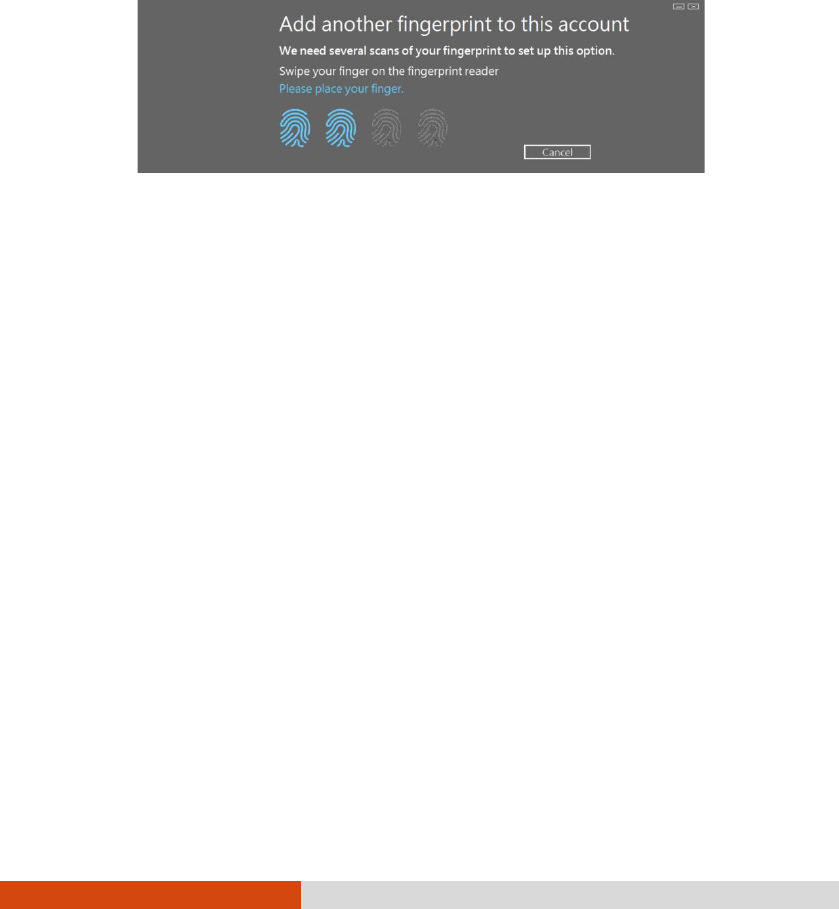
41
5. Put any finger of your choice on the scanner surface. Keep the finger still until
you’re asked to lift your finger and repeat the action again. Several scans of
the fingerprint are required.
NOTE: Put your finger in a natural position that matches the
way you normally hold your device.
6. When completed, tap
Finish
.
NOTE: For detailed information on the program, see the program’s
online help.
Fingerprint Logon
NOTE:
The fingerprint logon process can take a while. This is
because the system has to check hardware devices and security
configuration before initiating the fingerprint scanner.
The fingerprint scanner has 360-degree readability. You can
put your finger in any orientation for the scanner to
recognize an enrolled fingerprint.
With an enrolled fingerprint, the user can log on by tapping the Fingerprint option
in Windows logon screen and then placing the finger on the scanner. The user can
also dismiss the lock screen with the fingerprint.
If fingerprint logon attempts fail three times, you will be switched to password logon.

42
Cleaning the Fingerprint Scanner
You can use adhesive tape to remove dirt and oil from the scanner surface.
To clean with cleaner:
1. Shut down the Tablet PC, disconnect the AC adapter, and remove the battery
pack.
2. Slightly moisten a clean, lint-free cloth with household window cleaner. You can
also use a cotton swab as an alternative.
NOTE:
Do not use paper products to clean the scanner.
Do not use bleach, solvents, or abrasives.
Do not directly spray the scanner.
3. Gently rub the cloth over the scanner surface, turning the cloth to always use
a clean surface of the cloth.
4. After cleaning, gently rub the surface again with a clean, dry, lint-free cloth
or cotton swab.
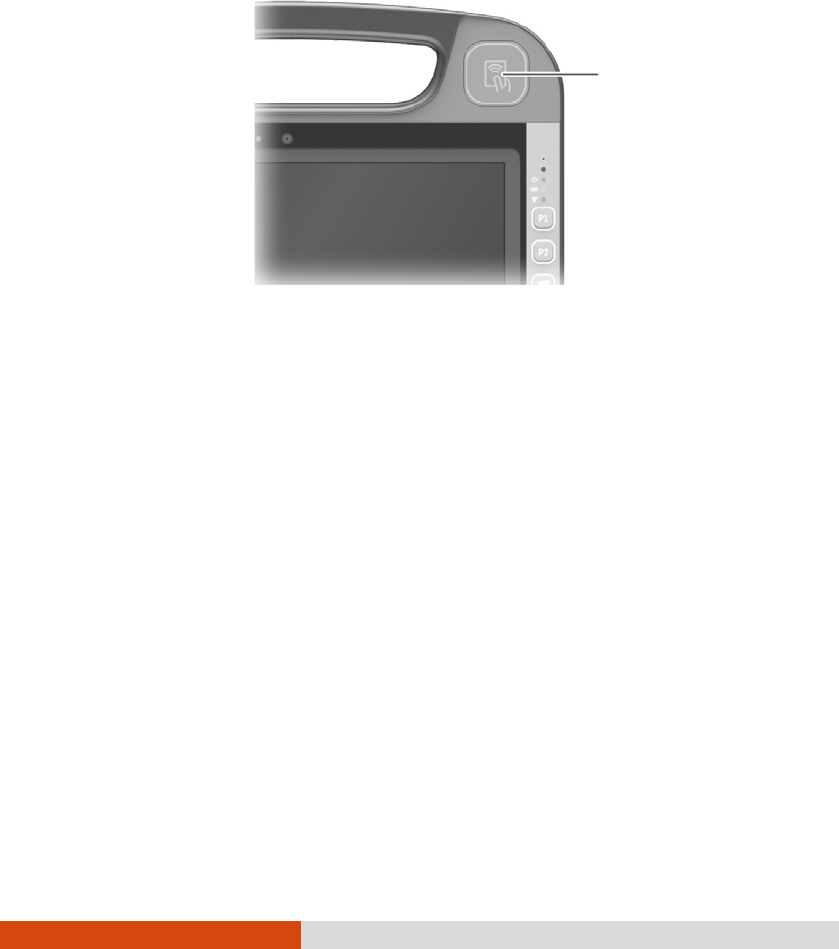
43
Using the NFC/RFID Reader (Optional)
If your model has the NFC /RFID reader module, you can read data from NFC
(Near Field Communication) devices and RFID (Radio Frequency Identification) tags.
NOTE:
For enhanced applications and customization of the module,
contact your authorized Getac dealer.
The NFC reader requires specialized applications. For
further information, ask your system administrator.
NFC/RFID reader
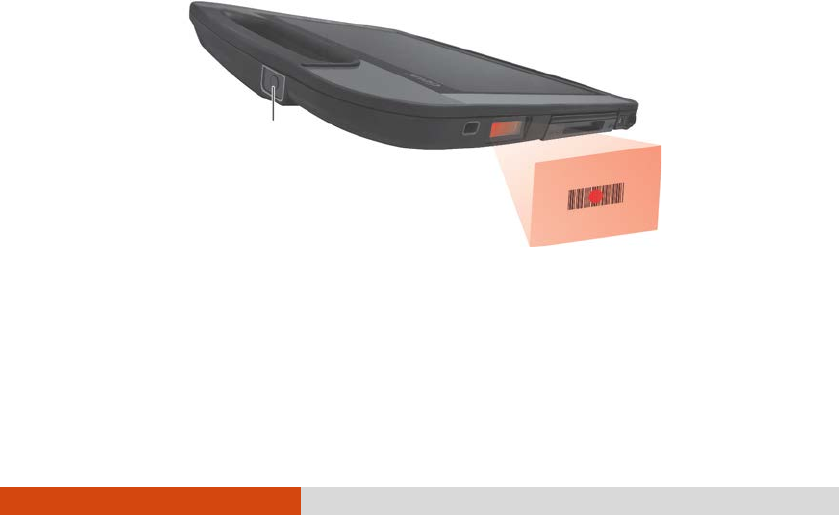
44
Using the Barcode Scanner (Optional)
NOTE:
For enhanced applications and customization of the module,
you can use the Barcode Manager program.
The maximum operating temperature for the barcode scanner
is 50 °C (122 °F).
If your model has the barcode scanner module, you can scan and decode most
common 1D and 2D symbologies.
To read barcodes:
1. Start your processing software and open a new or existing file. Place the insertion
point (or called cursor) where you want the data to be entered.
2. Press the Trigger button on your Tablet PC.
3. The barcode scanner shines red light with a center red dot. Aim the red dot
at the center of the barcode. The red light should cover the entire barcode.
Adjust the lens’ distance from the barcode, shorter for a smaller barcode and
farther for a larger one.
NOTE: A 15° scan angle in 323 lux (30 foot-candles) ambient
light produces the best scanning results.
4. Upon a successful scan, the system beeps and the decoded barcode data is
entered.
Trigger
button
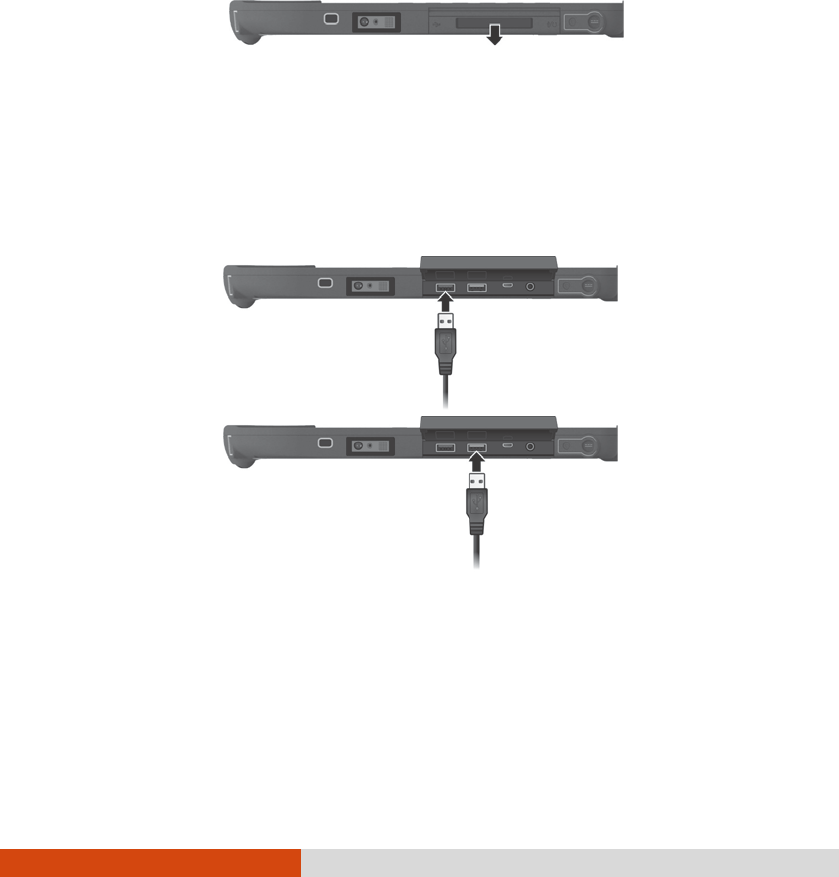
45
Connecting Peripheral Devices
You can expand the capabilities of your Tablet PC by connecting other peripheral
devices.
When using a device, be sure to read the instructions accompanying the device
together with the relevant section in this chapter.
Connecting a USB Device
Your Tablet PC has a USB 3.0 port and a USB 2.0 port for connecting USB devices,
such as a digital camera, scanner, printer, and mouse.
Slide down to open the
protective cover.
USB 3.0
USB 2.0
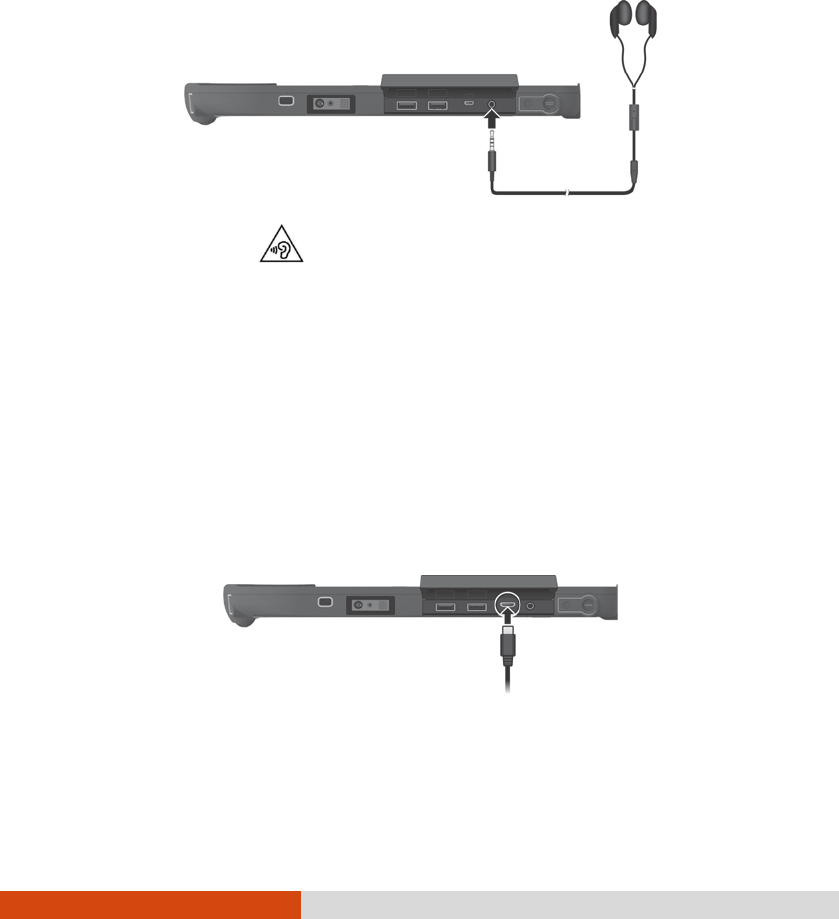
46
Connecting an Audio Device
For higher audio quality, you can send sound through an external audio device.
The audio combo connector is the “4-pole TRRS 3.5mm” type (Apple iPhone
Recessed) so you can connect a compatible headset microphone.
SAFETY WARNING:
To prevent possible hearing damage, do not listen at high volume
levels for long periods.
Connecting an HDMI Display Monitor
If you want the benefits of a larger display screen with higher resolution, you can
connect an external display monitor to your Tablet PC.
Your Tablet PC has a micro HDMI connector. HDMI (High-Definition Multimedia
Interface) is an audio/video interface that transmits uncompressed digital data and
therefore delivers true HD quality.
To switch the display output, use Window settings or OSD Control Panel.

47
Chapter 5
Using BIOS Setup
BIOS Setup Utility is a program for configuring the BIOS (Basic Input/ Output
System) settings of the computer. BIOS is a layer of software, called firmware, that
translates instructions from other layers of software into instructions that the computer
hardware can understand. The BIOS settings are needed by your computer to identify
the types of installed devices and establish special features.
This chapter tells you how to use the BIOS Setup Utility.
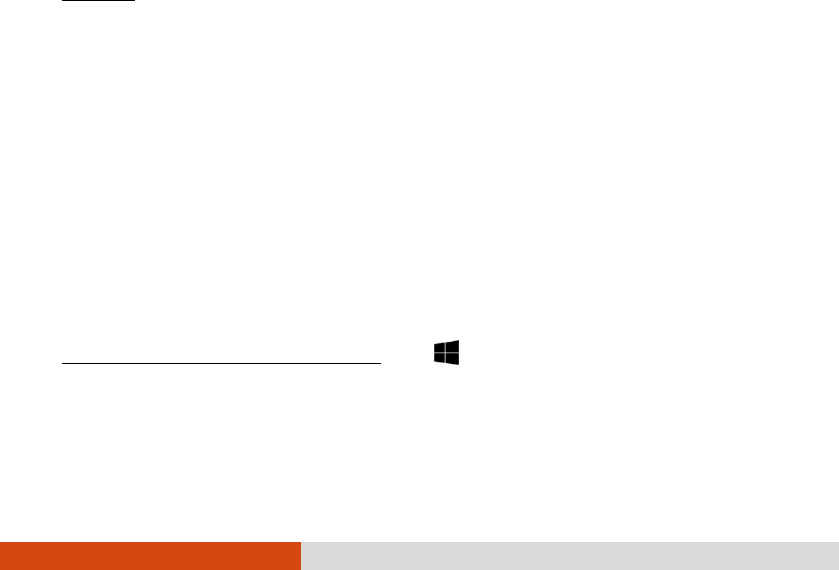
48
When and How to Use
NOTE:
The actual setting items on your model may differ from those
described in this chapter.
The availability of some setting items depends on the Windows
version your computer is running.
You need to run BIOS Setup Utility when:
You see an error message on the screen requesting you to run BIOS Setup
Utility.
You want to restore the factory default BIOS settings.
You want to modify some specific settings according to the hardware.
You want to modify some specific settings to optimize the system performance.
To run BIOS Setup Utility:
Method 1: During system startup when the logo screen appears, tap the screen (using
your finger, not the stylus) or press the Windows Logo button on your Tablet PC.
In the pre-boot menu that appears, select Setup Utility.
NOTE:
If you don’t want any accidental tapping to invoke the
pre-boot menu, you can disable this method by setting the
“Screen Tapping for Boot Options” item in the BIOS Setup Utility.
When tapping the screen for operating BIOS Setup, use your
finger. The touching of a stylus tip is not supported in this
situation.
For Windows 10 models, the time period in which you can use
the above method is extremely short. You can use the other
method as described below.
Method 2 (for Windows 10 models only): Tap Settings Update and security
Recovery. Under Advanced startup, tap Restart now. In the boot options menu,
tap Troubleshoot Advanced options UEFI Firmware Settings. Tap Restart.

49
Method 2 (for Windows 7 models only): If a keyboard is connected, press the
F2
key
during system startup when the logo screen appears.

50
Menu Descriptions
Information Menu
The Information menu contains the basic configuration information of the system.
There are no user-definable items in this menu.
NOTE: The “Asset Tag” information appears when you have entered
the asset number for this Tablet PC using the asset management
program. The program is provided in the Asset tag folder of the
Driver disc.
Main Menu
The Main menu contains the various system settings.
System Date
sets the system date.
System Time
sets the system time.
OS Select
specifies which version of Windows your computer is running.
Legacy USB Support
enables or disables the system’s support for Legacy USB.
CSM Support enables or disables CSM (Compatibility Support Mode). You can
set this item to Yes for backward compatibility with legacy BIOS services.
PXE Boot sets the PXE boot to
UEFI
or
Legacy
. PXE (Preboot eXecution
Environment) is an environment to boot computers using a network interface
independently of data storage devices or installed operating systems.

51
Advanced Menu
The Advanced menu contains the advanced settings.
Wake Up Capability
USB Wake-Up From S3 allow a USB device activity to wake up the system from
S3 (Sleep) state.
Power Button Delay
sets power button delay time (1 second or 2 seconds) so
that accidental touching of the :power button does not cause undesired operation.
You can also disable the delay.
System Policy allows you to choose between
Performance
and
Balance
. If battery
life is your first priority, select
Balance
. If you need system performance more
than battery life, select
Performance
.
AC Initiation
sets if connecting AC power will automatically start or resume the
system.
Screen Tapping for Boot Options sets if tapping the screen during startup will
invoke the boot options menu which provides access to some pre-boot operations.
If disabled, tapping the screen during startup has no effect to the system’s booting
process.
Charging Bridge Battery allows the main battery to charge the bridge battery.
When set to
Enabled
, the bridge battery can be charged by the main battery
if the AC adapter is not connected. When set to
Disabled
, the bridge battery
will be charged by the AC adapter only.
Active Management Technology Suppor
t (This item appears only on models
supporting vPro.)
Intel AMT Support enables or disables Intel® Active Management Technology BIOS
extension execution. AMT allows the system administrator to access an AMT
featured computer remotely.
Intel AMT Setup Prompt
determines whether the prompt for entering Intel MEBx
Setup appears or not during POST.
Virtualization Technology Setup
Intel(R) Virtualization Technology
enables or disables Intel® VT (Intel

52
Virtualization Technology) feature which provides hardware support for processor
virtualization. When enabled, a VMM (Virtual Machine Monitor) can utilize the
additional hardware virtualization capabilities provided by this technology.
Intel(R) VT for Directed I/O (VT-d)
enables or disables VT-d (Intel® Virtualization
Technology for Directed I/O). When enabled, VT-d helps enhance Intel platforms
for efficient virtualization of I/O devices.
Graphics Setup
DVMT Pre-Allocated
sets the amount of pre-allocated (fixed) graphics memory
for use by the internal graphics device.
Device Configuration enables or disables several hardware components. The
items available for setting depend on your model.
Security Menu
The Security menu contains the security settings, which safeguard your system against
unauthorized use.
NOTE:
You can set the user password only when the supervisor
password has been set.
If both the supervisor and user passwords are set, you can
enter any of them for starting up the system and/or entering
BIOS Setup. However, the user password only allows you to
view/change the settings of certain items.
A password setting is applied right after it is confirmed.
To cancel a password, leave the password empty by pressing
the Enter key.
Set Supervisor/User Password
sets the supervisor/user password. You can set
the supervisor/user password to be required for starting up the system and/or
entering BIOS Setup.
Password on Boot
allows you to enable or disable the entering of password for
booting up your system. (This item appears only on Windows 7 models.)

53
Set HDD 0 User Password
sets the password for locking the Primary Master hard
disk drive. After setting a password, the hard disk drive can only be unlocked
by the password no matter where it is installed.
TPM Setup Menu
TPM Support
enables or disables TPM (Trusted Platform Module) support. TPM
(Trusted Platform Module) is a component on your computer’s mainboard that
is specifically designed to enhance platform security by providing a protected
space for key operations and other security critical tasks.
Change TPM Status
allows you to select between
No Change
,
Clear
,
Enable and
Activate
, and
Disable and Deactivate
.
Intel Trusted Execution Technology enables utilization of additional hardware
capabilities provided by Intel® Trusted Execution Technology.
Boot Menu
The Boot menu sets the sequence of the devices to be searched for the operating
system.
Boot Type Order determines the boot order. You can rearrange the order by
dragging the boot device name up or down in the list.
Each boot device can be individually set to
On
or
Off
. If you want to exclude
a boot device from the boot order, set the device to
Off
.
Exit Menu
The Exit menu displays ways of exiting BIOS Setup Utility. After finishing with your
settings, you must save and exit so that the changes can take effect.
Exit Saving Changes
saves the changes you have made and exits BIOS Setup
Utility.
Exit Discarding Changes
exits BIOS Setup Utility without saving the changes you
have made.
Load Setup Defaults
loads the factory default values for all the items.

54
Discard Changes
restores the previous values for all the items.
Saves Changes
saves the changes you have made.

55
Chapter 6
Using Getac Software
Getac software includes application programs for specific computer components and
utility programs for overall management.
This chapter briefly introduces the programs.
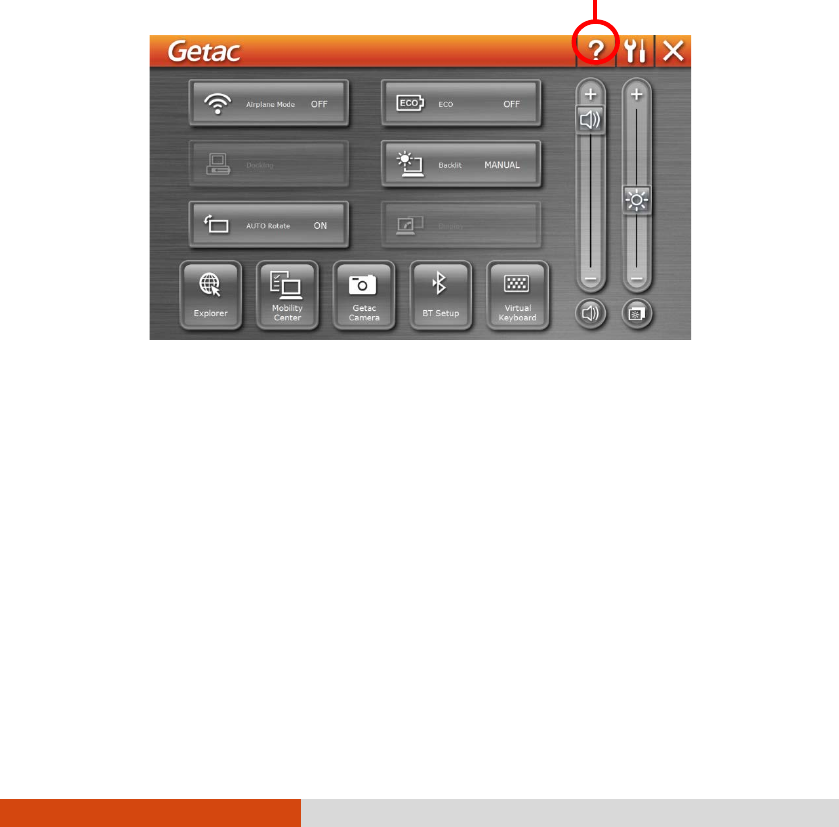
56
OSD Control Panel
The OSD (On Screen Display) Control Panel provides a user-friendly interface for
you to quickly activate or operate certain functions on your Tablet PC with a simple
tap of the screen.
To open the OSD Control Panel, start the program named
OSDC.
You can also press
the P2 button on your Tablet PC to open it. The following screen appears.
For detailed information on the program, see the program’s online help.
Help
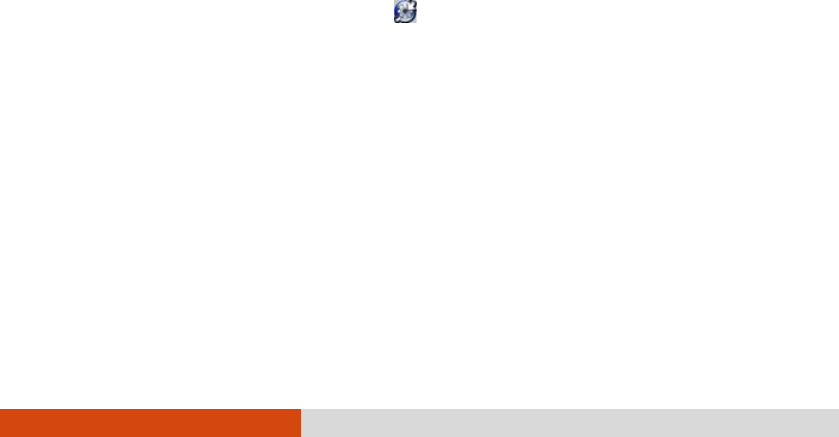
57
G-Manager
G-Manager is a unified user interface utility that allows you to view, manage, or
configure your computer features.
With G-Manager, you can perform all or some of the tasks listed below.
View system information.
Check the battery status and configure the battery.
Configure ECO modes (or called power profiles).
Set the touchscreen sensitivity mode.
Set if a warning message will appear when a connected docking station is
removed unexpectedly.
Enable the use of external GPS/WWAN/WLAN antenna signal.
Change the function of the hardware button.
Configure how your system works with the vehicle ignition.
Monitor the system.
View GPS information.
Tap and hold the Getac Utility icon located on Windows taskbar and select
G-Manager to start the program. The G-Manager window appears, containing several
tabs.
NOTE: Depending on your model, the actual items and information
appearing on the screen may differ from those shown in this
manual.
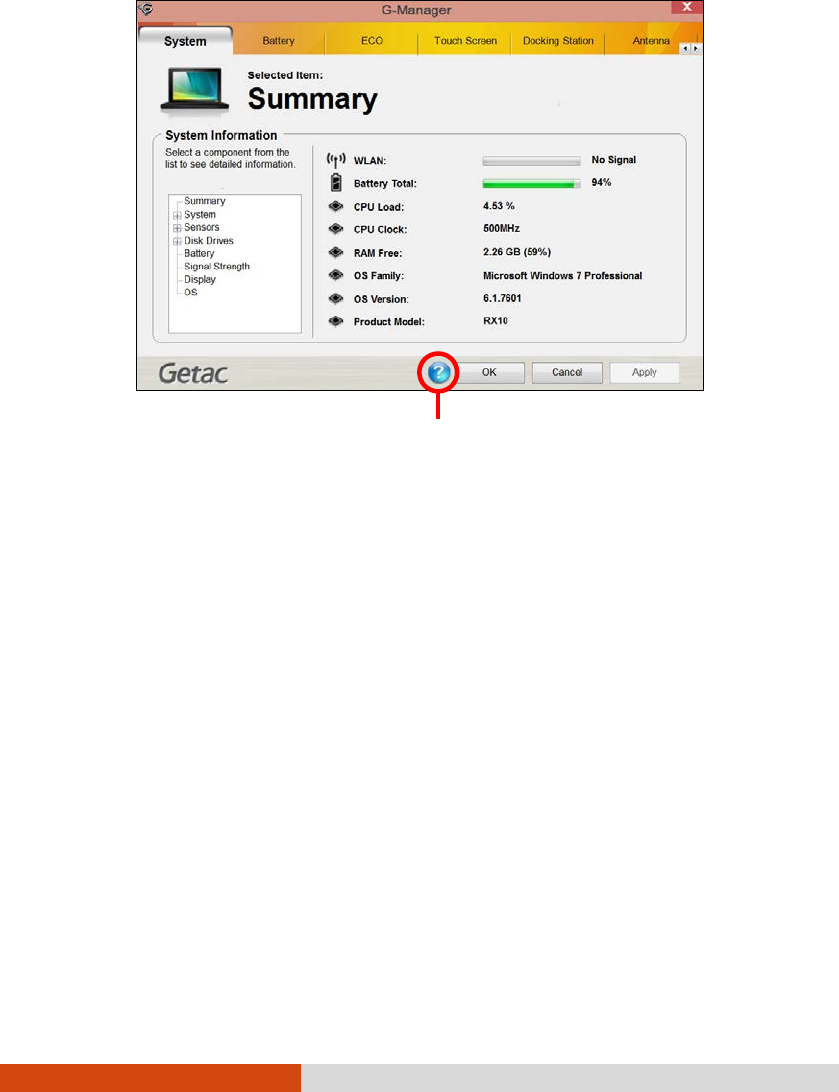
58
For detailed information on the program, see the program’s online help.
Help
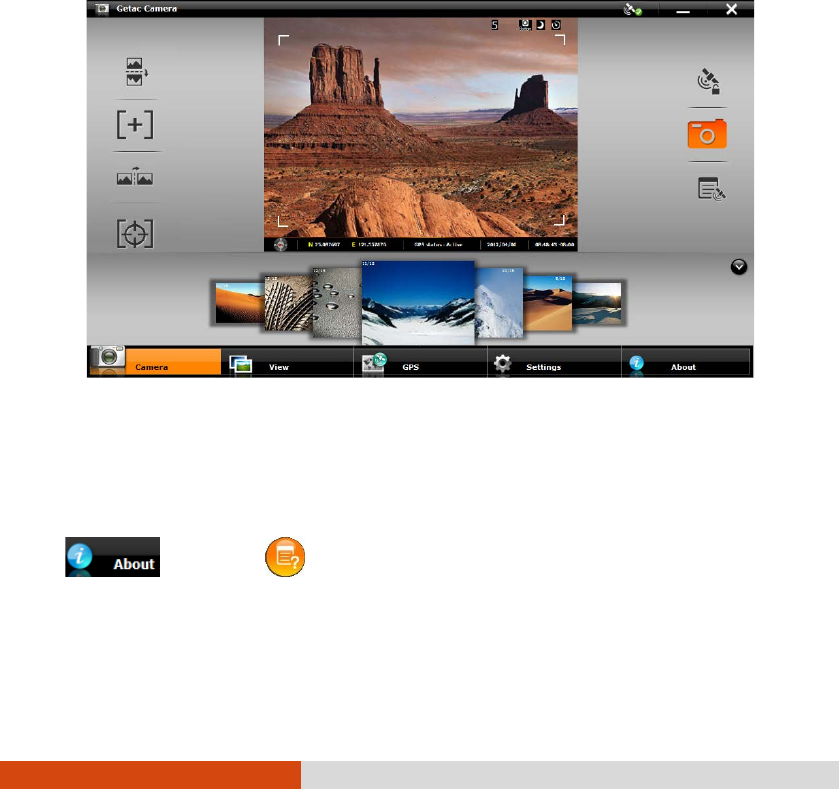
59
Getac Camera
Getac Camera is a geo-tagging camera program, which allows you to stamp
geographical information on photos as watermarks and embed such information into
JPEG/BMP files as EXIF 2.2 metadata.
NOTE: Before starting Getac Camera, close any other program that
uses the camera; otherwise, Getac Camera can only provide
limited functions.
Start Getac Camera. The Getac Camera window appears as shown below.
By default, the program starts to determine your location using GPS positioning.
When the GPS positioning is completed, you will see the geographical information
in the watermark area on the image.
For detailed information on the program, see the program’s online help. Tap
and then .

60
Chapter 7
Caring for the
Tablet PC
Taking good care of your Tablet PC will ensure a trouble-free operation and reduce
the risk of damage to your Tablet PC.
This chapter gives you guidelines covering areas such as protecting, storing, cleaning,
and traveling.

61
Taking Care of the Tablet PC
Location Guidelines
For optimal performance, use the Tablet PC where the recommended temperature
is between 0 °C (32 °F) and 55 °C (131 °F). (Actual operating temperature
depends on product specifications.)
Avoid placing the Tablet PC in a location subject to high humidity, extreme
temperatures, mechanical vibration, direct sunlight, or heavy dust. Using in
extreme environments for long periods can result in product deterioration and
a shortened product life.
Operating in an environment with metallic dust is not allowed.
Place the Tablet PC on a flat and steady surface. Do not stand the Tablet
PC on its side or store it in an upside-down position. A strong impact by dropping
or hitting may damage the Tablet PC.
Do not cover or block any ventilation openings on the Tablet PC. For example,
do not place the Tablet PC on a bed, sofa, rug, or other similar surface.
Otherwise, overheating may occur that results in damage to the Tablet PC.
As the Tablet PC can become very hot during operation, keep it away from
objects that are vulnerable to heat.
Keep the Tablet PC at least 13 cm (5 inches) away from electrical appliances
that can generate a strong magnetic field such as a TV, refrigerator, motor,
or a large audio speaker.
Avoid moving the Tablet PC abruptly from a cold to a warm place.
A temperature difference of more than 10 °C (18 °F) may cause condensation
inside the unit, which may damage the storage media.
General Guidelines
Do not expose your skin to the Tablet PC when operating it in a very hot or
cold environment.

62
Do not place heavy objects on top of the Tablet PC as this may damage the
display.
The screen surface is easily scratched. Avoid touching it with a sharp object
such as a pen or pencil.
LCD image sticking occurs when a fixed pattern is displayed on the screen for
a prolonged period of time. You can avoid the problem by limiting the amount
of static content on the display. It is recommended that you use a screen saver
or turn off the display when it is not in use.
To maximize the life of the backlight in the display, allow the backlight to
automatically turn off as a result of power management.
Cleaning Guidelines
Never clean the Tablet PC with its power on.
Use a soft cloth moistened with water or a non-alkaline detergent to wipe the
exterior of the Tablet PC.
Gently wipe the display with a soft, lint-free cloth.
If water or liquid is split onto the Tablet PC, wipe it dry and clean when possible.
Though your Tablet PC is water-proof, do not leave the Tablet PC wet when
you can dry it.
If the Tablet PC gets wet where the temperature is 0°C (32°F) or below,
freeze damage may occur. Make sure to dry the wet Tablet PC.
Battery Pack Guidelines
Recharge the battery pack when it is nearly discharged. When recharging, make
sure that the battery pack is fully charged. Doing so may avoid harm to the
battery pack.
The battery pack is a consumable product and the following conditions will shorten
its life:
– when frequently charging the battery pack

63
– when using, charging, or storing the battery in high temperature
condition
To avoid hastening the deterioration of the battery pack thereby prolonging its
useful life, minimize the number of times you charge it so as not to frequently
increase its internal temperature.
Charge the battery pack between 10 °C ~ 30 °C (50 °F ~ 86 °F) temperature
range. A higher environment temperature will cause the battery pack’s temperature
to rise. Avoid charging the battery pack inside a closed vehicle and in hot weather
condition. Also, charging will not start if the battery pack is not within the allowed
temperature range.
It is recommended that you do not charge the battery pack more than once
a day.
It is recommended that you charge the battery pack with the Tablet PC’s power
off.
To maintain the battery pack’s operating efficiency, store it in a cool dark place
removed from the Tablet PC and with 30 % ~ 40 % charge remaining.
Important guidelines when using the battery pack.
When installing or removing the battery pack take note of the following:
– avoid installing or removing the battery pack when the Tablet PC is
in Sleep mode. Abruptly removing the battery pack may cause
loss of data or the Tablet PC may become unstable.
– avoid touching the battery pack terminals or damage may occur,
thereby causing improper operation to it or the Tablet PC.
The Tablet PC’s input voltage and surrounding temperature will directly affect
the battery pack’s charge and discharge time:
– charging time will be prolonged when the Tablet PC is turned on.
To shorten the charging time, it is recommended that you place the
Tablet PC in Sleep or hibernation mode.
– a low temperature will prolong the charging time as well as hasten
the discharge time.

64
When using battery power in an extremely low temperature environment, you
may experience shortened operating time and incorrect battery level reading. This
phenomenon comes from the chemical characteristics of batteries. The appropriate
operating temperature for the battery is -10 °C ~ 50 °C (14 °F ~ 122 °F).
Do not leave the battery pack in storage for more than six months without
recharging it.
Touchscreen Guidelines
Use the finger or the included stylus on the display. Using a sharp or metallic
object other than your finger or stylus may cause scratches and damage the
display, thereby causing errors.
Use a soft cloth to remove dirt on the display. The touchscreen surface has
a special protective coating that prevents dirt from sticking to it. Not using a
soft cloth may cause damage to the special protective coating on the touchscreen
surface.
Turn off the Tablet PC power when cleaning the display. Cleaning the display
with the power on may cause improper operation.
Do not use excessive force on the display. Avoid placing objects on top of the
display as this may cause the glass to break thereby damaging the display.
Using the touchscreen during low temperature (less than 5 oC) may cause
a slower response time, this is normal. A normal response time may be restored
upon returning to room temperature.
When there is noticeable discrepancy in the operation of the touchscreen function
(wrong location on intended operation or improper display resolution), refer to
the Windows online Help for instructions on recalibrating the touchscreen display.

65
When Traveling
Make sure that the battery pack is fully charged.
Make sure that the Tablet PC is turned off.
Disconnect the AC adapter from the Tablet PC and take it with you. Use the
AC adapter as the power source and as a battery-charger.
Put the Tablet PC in a protective case. Hand-carry the Tablet PC. Do not
check it in as luggage.
If you need to leave the Tablet PC in the car, put it in the trunk of the car
to avoid exposing the Tablet PC to excessive heat.
When going through airport security, it is recommended that you send the Tablet
PC and flash disks through the X-ray machine (the device you set your bags
on). Avoid the magnetic detector (the device you walk through) or the magnetic
wand (the handheld device used by security personnel).
If you plan to travel abroad with your Tablet PC, consult your dealer for the
appropriate AC power cord for use in your country of destination.

66
Chapter 8
Troubleshooting
Computer problems can be caused by hardware, software, or both. When you
encounter any problem, it might be a typical problem that can easily be solved.
This chapter tells you what actions to take when solving common computer problems.

67
Preliminary Checklist
Here are helpful hints to follow before you take further actions when you encounter
any problem:
Try to isolate which part of the Tablet PC is causing the problem.
Make sure that you turn on all peripheral devices before turning on the Tablet
PC.
If an external device has a problem, make sure that the cable connections are
correct and secure.
Make sure that the configuration information is properly set in the BIOS Setup
program.
Make sure that all the device drivers are correctly installed.
Make notes of your observations. Are there any messages on the screen? Do
any indicators light? Do you hear any beeps? Detailed descriptions are useful
to the service personnel when you need to consult one for assistance.
If any problem persists after you follow the instructions in this chapter, contact an
authorized dealer for help.

68
Solving Common Problems
Battery Problems
The battery does not charge (Battery Charge Indicator does not light amber).
Make sure that the AC adapter is properly connected.
Make sure that the battery is not too hot or cold. Allow time for the battery
pack to return to room temperature.
If the battery doesn't charge after it has been stored in very low temperatures,
try disconnecting and reconnecting the AC adapter to solve the problem.
Make sure that the battery pack is installed correctly.
Make sure that the battery terminals are clean.
The operating time of a fully charged battery becomes shorter.
If you often partially recharge and discharge, the battery might not be charged
to its full potential. Initialize the battery to solve the problem.
The battery operating time indicated by the battery meter does not match the
actual operating time.
The actual operating time can be different from the estimated time, depending
on how you are using the Tablet PC. If the actual operating time is much less
than the estimated time, initialize the battery.
BT
Wireless Transmission Problems
I cannot connect to another device with BT wireless technology.
Make sure that both devices have activated BT feature.
Make sure that the distance between the two devices is within the limit and
that there are no walls or other obstructions between the devices.
Make sure that the other device is not in “Hidden” mode.

69
Make sure that both devices are compatible.
Display Problems
Nothing appears on the screen.
During operation, the screen may automatically turn off as a result of power
management. Press any key to see if the screen comes back.
The brightness level might be too low. Increase the brightness.
The characters on the screen are dim.
Adjust the brightness and/or contrast.
The display brightness cannot be increased.
As a protection, the display brightness will be fixed at a low level when the
surrounding temperature is too high or too low. It is not a malfunction in this
situation.
Bad dots appear on the display at all times.
A small number of missing, discolored, or bright dots on the screen are an
intrinsic characteristic of TFT LCD technology. It is not regarded as a LCD defect.
Clouding (or called “mura”) happens on the screen when you exert forces on
the left or right side of the LCD frame.
This is a normal phenomenon, not a defect.
Hardware Device Problems
The Tablet PC does not recognize a newly installed device.
The device may not be correctly configured in the BIOS Setup program. Run
the BIOS Setup program to identify the new type.
Make sure if any device driver needs to be installed. (Refer to the documentation
that came with the device.)

70
Make sure if the device needs any jumper or switch settings. (Refer to the
documentation that came with the device.)
Check the cables or power cords for correct connections.
For an external device that has its own power switch, make sure that the power
is turned on.
Power Management Problems
The Tablet PC does not enter Sleep or Hibernation mode automatically.
If you have a connection to another computer, the Tablet PC does not enter
Sleep or Hibernation mode if the connection is actively in use.
Make sure that the Sleep or Hibernation time-out is enabled.
The Tablet PC does not enter Sleep or Hibernation mode immediately.
If the Tablet PC is performing an operation, it normally waits for the operation
to finish.
The Tablet PC does not resume from Sleep or Hibernation mode.
The Tablet PC automatically enters Sleep or Hibernation mode when the battery
pack is empty. Do any one of the following:
− Connect the AC adapter to the Tablet PC.
− Replace the empty battery pack with a fully charged one.
Sensor Problems (for Windows 10 Models Only)
The built-in digital compass doesn’t seem to be accurate.
Rotating the display can affect the accuracy of the digital compass. This is normal,
not a malfunction. The sensors for the compass require periodic recalibration.
Follow this method to recalibrate the sensors:
1. Make sure you are far away from any large metal objects or magnetic fields.
2. Start an application that utilizes the digital compass.
3. Hold the Tablet PC level with the horizon, with the LCD side facing up.
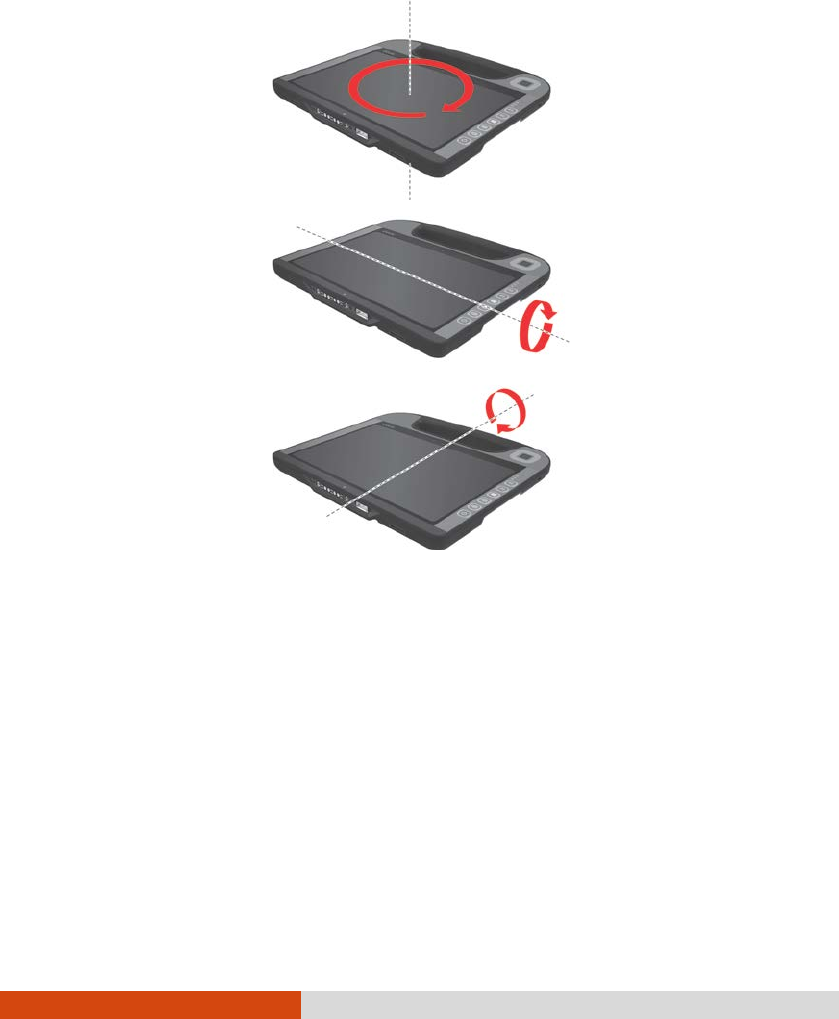
71
4. Rotate the Tablet PC 360° at least three times around each axis (X, Y,
and Z) as shown below.
Software Problems
An application program does not work correctly.
Make sure that the software is correctly installed.
If an error message appears on the screen, consult the software program’s
documentation for further information.
If you are sure the operation has stop, reset the Tablet PC.

72
Sound Problems
No sound is produced.
Make sure that the volume control is not set too low. Increase the volume.
Make sure that the sound is not muted.
Make sure that the Tablet PC is not in Sleep mode.
If using an external speaker, make sure that the speaker is properly connected.
Distorted sound is produced.
Make sure that the volume control is not set too high or too low. In most cases,
a high setting can cause the audio electronics to distort the sound.
Startup Problems
When you turn on the Tablet PC, it does not respond and the Power Indicator
does not light green.
If you are using an external AC power, make sure that the AC adapter is correctly
and securely connected. If so, make sure that the electrical outlet works properly.
If you are using the battery power, make sure that the battery is not discharged.
When you turn on the Tablet PC, it stops after POST.
Reset your Tablet PC.
WLAN Problems
I cannot use the WLAN feature.
Make sure that the WLAN feature is turned on.
Transmission quality is poor.
Your Tablet PC may be in an out-of-range situation. Move your Tablet PC
closer to the Access Point or another WLAN device it is associated with.

73
Check if there is high interference around the environment and solve the problem
as described next.
Radio interference exists.
Move your Tablet PC away from the device causing the radio interference such
as microwave oven and large metal objects.
Plug your Tablet PC into an outlet on a different branch circuit from that used
by the affecting device.
Consult your dealer or an experienced radio technician for help.
I cannot connect to another WLAN device.
Make sure that the WLAN feature is turned on.
Make sure that the SSID setting is the same for every WLAN device in the
network.
Your Tablet PC is not recognizing changes. Restart the Tablet PC.
Make sure that the IP address or subnet mask setting is correct.
I cannot communicate with the computer in the network when Infrastructure
mode is configured.
Make sure that the Access Point your Tablet PC is associated with is powered
on and all the LEDs are working properly.
If the operating radio channel is in poor quality, change the Access Point and
all the wireless station(s) within the BSSID to another radio channel.
Your Tablet PC may be in an out-of-range situation. Move your Tablet PC
closer to the Access Point it is associated with.
Make sure that your Tablet PC is configured with the same security option
(encryption) to the Access Point.
Use the Web Manager/Telnet of the Access Point to check whether it is connected
to the network.

74
Reconfigure and reset the Access Point.
I cannot access the network.
Make sure that the network configuration is appropriate.
Make sure that the user name or password is correct.
You have moved out of range of the network.
Turn off power management.
Other Problems
The date/time is incorrect.
Correct the date and time via the operating system or BIOS Setup program.
After you have performed everything as described above and still have the
incorrect date and time every time you turn on the Tablet PC, the RTC
(Real-Time Clock) battery is at the end of its life. Call an authorized dealer
to replace the RTC battery.

75
Resetting the Tablet PC
You may have to reset (reboot) your Tablet PC on some occasions when an error
occurs and the program you are using hangs up.
If you are sure the operation has stopped and you cannot use the “restart” function
of the operating system, reset the Tablet PC.
Reset the Tablet PC by any one of these methods:
Press and hold the
P2
button for more than 2 seconds. This opens the
Ctrl-Alt-Del
screen where you can select actions including
Restart
.
If the above action does not work, press and hold the power button for more
than 5 seconds to force the system to turn off. Then turn on the power again.

76
System Recovery
System Recovery (a Tool for Windows 7 Models)
Use System Recovery when:
The Windows 7 operating system does not start at all.
You want to restore the system to the factory state.
WARNING:
Using this feature will reinstall Windows to your system and
configure it to the system’s factory default settings. All
data on the hard disk drive will be lost.
Make sure that power is not interrupted during the recovery
process. An unsuccessful recovery may result in Windows
startup problems.
To run System Recovery:
1. Connect the AC adapter.
2. Turn on the Tablet PC. During system startup when the logo screen appears,
tap the screen or press the Windows Logo button on your Tablet PC. In the
pre-boot menu that appears, select Recovery.
Or, if a keyboard is connected, you can press
Ctrl
+
Alt
+
F2
keys for four seconds
instead of tapping the screen.
3. In the screen that appears, select
Recovery
to start the recovery process.
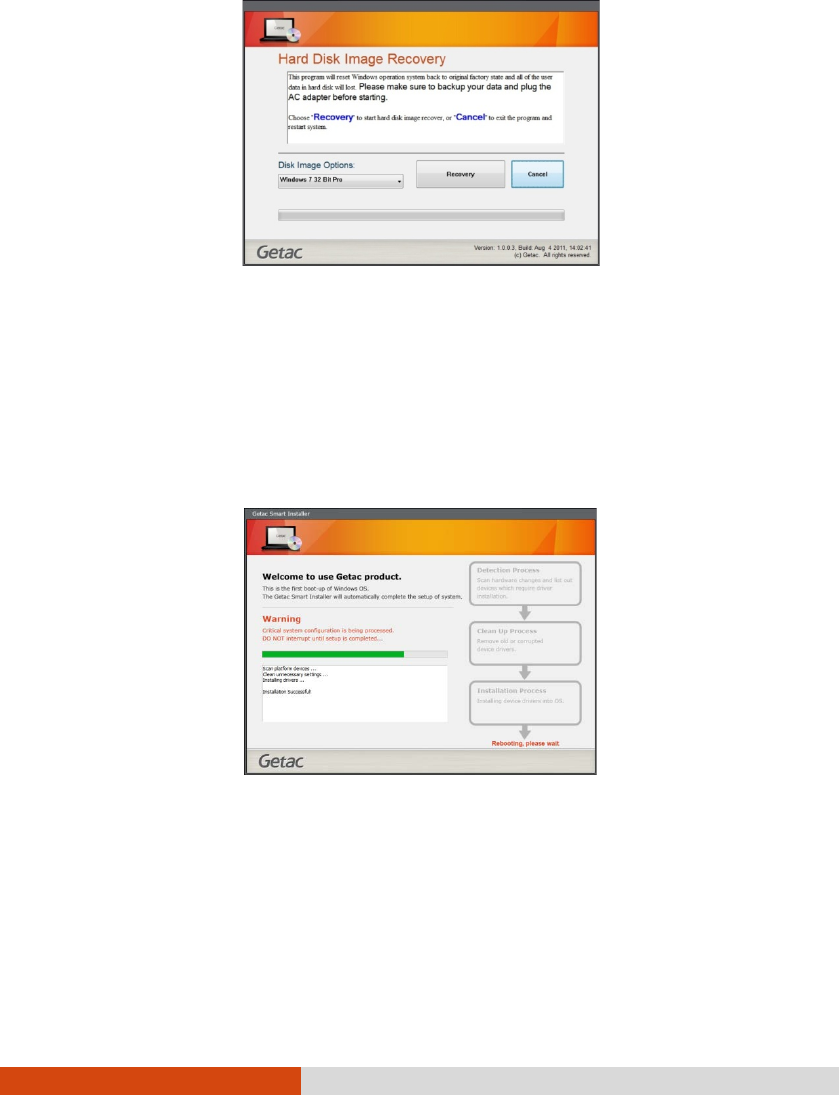
77
4. The progress bar shows the percentage completed. When it reaches 100%, the
system turns off.
5. Turn on the Tablet PC. The Windows setup wizard starts. Follow the onscreen
prompts to continue.
6. When the system restarts, the installer screen appears. The installer will perform
system hardware detection and driver installation.
7. When completed, the system restarts and displays Windows desktop.

78
Using the Driver Disc
The Driver disc contains drivers and utilities required for specific hardware in your
Tablet PC.
Since your Tablet PC comes with drivers and utilities pre-installed, you normally
do not need to use the Driver disc. In case you want to manually install Windows,
you will have to install the drivers and utilities one by one after installing Windows.
To manually install drivers and utilities:
1. Start up the Tablet PC.
2. Prepare an external CD/DVD drive (with USB connection). Connect the drive
to your Tablet PC. Wait for the Tablet PC to recognize the drive.
3. Insert the Driver disc. Make sure you use the disc that matches the Windows
version of your Tablet PC.
4. The autorun program should automatically start. You will see the installation menu.
Tap NEXT to go to the next page if there is more than one.
5. To install a driver or utility, just tap the particular button and follow the onscreen
instructions to complete the installation.
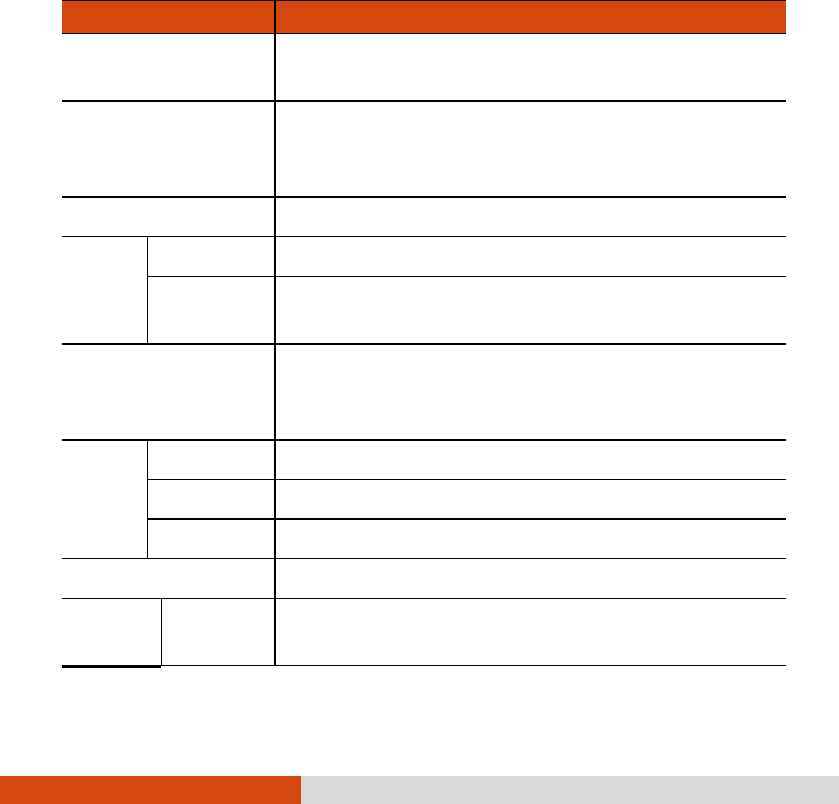
79
Appendix A
Specifications
NOTE: Specifications are subject to change without any prior
notice.
Parts
Specifications
CPU Intel® Core™ M-5Y71/ M-5Y10c Processor, 4.5W,
Turbo Boost Technology
BIOS Insyde, 16MB flash EEPROM, supporting UEFI, ACPI,
TPM, vPro (optional), AMT10, computrace (optional),
and security eraser
RAM 4GB/8GB LPDDR3 1.2V 1600MHz SO-DIMM
Video Controller UMA - Intel® HD 5300 Graphics
Display Panel
10.1-inch TFT LCD, widescreen and full HD,
1920 x
1200, dimmer mode, blackout mode, light sensor
Touchscreen Capacitive multi-touch screen - 10 point, g
love enabled
touch, palm rejection, large area of water freeze
Option: Digitizer
Audio Features Realtek High Definition Audio
Speaker 85db
Microphone Integrated microphone
Hard disk drive 64/128/256 GB SSD (Solid-State Disk), SATA interface
I/O ports
Standard USB 3.0, USB 2.0, micro HDMI, combo audio (4-
pole
TRRS 3.5mm type)
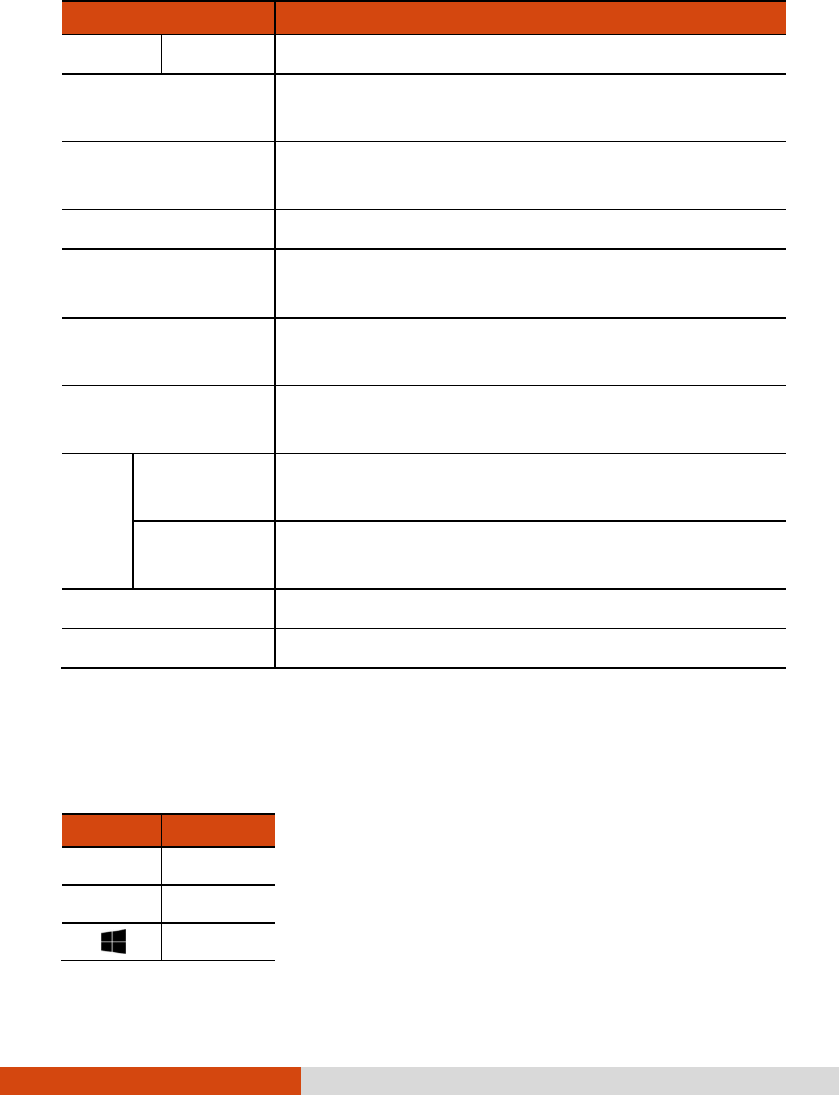
80
Parts
Specifications
Optional Barcode scanner, Tri Pass-through
Wireless LAN + BT IEEE 802.11ac, compatible with 802.11a/b/g/n,
BT 4.0 + EDR
Camera Front: HD, blue LED
Rear: 8M pixel, autofocus, blue LED, video capture
GPS (option) UART
WWAN (option) 3G/4G LTE(AirPrime EM7305)
GSM900/1800/WCDMA/CDMA2000/LTE 900/LTE1800
NFC/RFID Reader
(option)
ISO15693, ISO18000-3, ISO14443A/B, Mifare, FeliCa™
Security TPM 2.0
Fingerprint scanner (optional)
Power
AC adapter Universal 65 W; input: 100∼240 V
, 50/60 Hz; output:
19V
Battery pack Lithium-ion Prismatic type, 4-cell
Hot Swap technology with bridge battery
Dimension (LxW×D) 280 x 245 x 18.8 mm (11.02 × 9.64 × 0.74 inch)
Weight 1.2 kg (2.64 lb)
Button Functions on Special Occasions
On “POST/BIOS Setup/Non-ACPI” occasions, the five hardware buttons provide
keyboard key functions as described below.
Button
Function
P1
Tab
P2
Esc
Enter
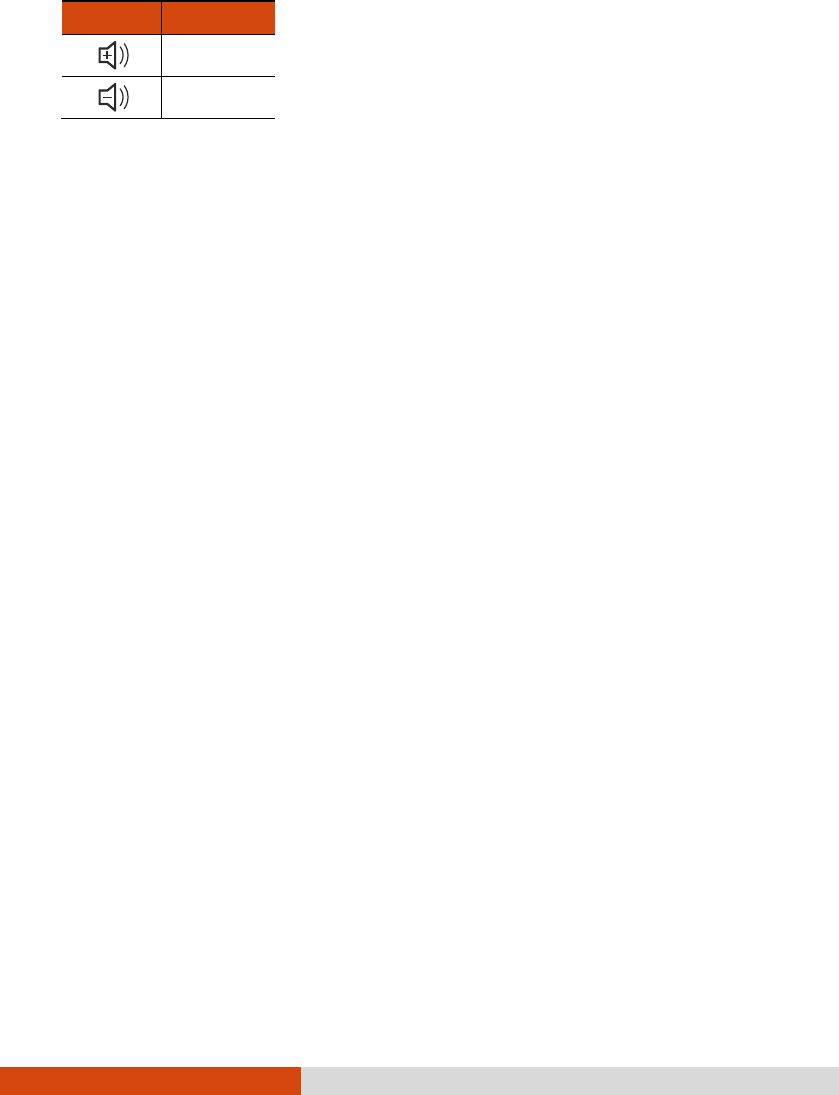
81
Button
Function
↑
Up
↓
Down

82
Appendix B
Regulatory Information
This appendix provides regulatory statements and safety notices on your Tablet PC.
NOTE: Marking labels located on the exterior of your Tablet PC
indicate the regulations that your model complies with. Please
check the marking labels and refer to the corresponding
statements in this appendix. Some notices apply to specific
models only.

83
On the Use of the System
Class B Regulations
USA
Federal Communications Commission Radio Frequency Interference Statement
NOTE:
This equipment has been tested and found to comply with the limits for a Class
B digital device pursuant to Part 15 of the FCC Rules. These limits are designed
to provide reasonable protection against harmful interference in a residential installation.
This equipment generates, uses, and can radiate radio frequency energy and, if not
installed and used in accordance with the instructions, may cause harmful interference
to radio communications. However, there is no guarantee that interference will not occur
in a particular installation. If this equipment does cause harmful interference to radio
or television reception, which can be determined by turning the equipment off and
on, the user is encouraged to try to correct the interference by one or more of the
following measures:
Reorient or relocate the receiving antenna.
Increase the separation between the equipment and receiver.
Connect the equipment into an outlet on a circuit different from that to which
the receiver is connected.
Consult the dealer or an experienced radio/TV technician for help.
Any changes or modifications not expressly approved by the manufacturer could void
the user’s authority to operate the equipment.
Please note:
The use of a non-shielded interface cable with this equipment is prohibited.
Operation on the 5.15-5.25 GHz frequency band is restricted to indoor use
only.

84
Canada
Canadian Department of Communications
Radio Interference Regulations Class B Compliance Notice
This Class B digital apparatus meets all requirements of the Canada
Interference-Causing equipment regulations.
Cet appareil numérique de Classe B respecte toutes les exigences du Règlement
Canadien sur le matériel brouileur.
This digital apparatus does not exceed the Class B limits for radio noise emissions
from digital apparatus set out in the Radio Interference Regulations of the Canadian
Department of Communications.
Le présent appareil numérique n’émet pas de bruits radioélectriques dépassant les
limites applicables aux appareils numériques de la classe B prescrites dans le
Règlement sur le brouillage radioélectrique édicté par le ministère des Communications
du Canada.
Taiwan
「減少電磁波影響,請妥適使用」
ANSI Warning
Equipment approved for ANSI/ISA 12.12.01, Nonincendive Electrical Equipment for
use in Class 1, Division 2, Group A, B, C, and D.
Maximum ambient temperature: 40°C
WARNING: To prevent ignition of a hazardous atmosphere, batteries must only
be changed or charged in an area known to be non-hazardous.
EXPLOSION HARZARD WARNING: External connections/hubs through the connectors
as mentioned (USB connector, Ethernet connector, video port, serial port, power
supply connector, microphone jack, headphones jack, and buttons/switches) are
not to be used in a hazardous location.
Power adapter shall not be used in hazardous locations.

85
Safety Notices
About the Battery
Caution Texts Concerning Lithium Batteries
DANISH
ADVARSEL! Lithiumbatteri – Eksplosionsfare ved fejlagtig håndtering. Udskiftning må
kun ske med batteri af samme fabrikat og type. Levér det brugte batteri tilbage
til leverandøren.
NORWEGIAN
ADVARSEL: Eksplosjonsfare ved feilaktig skifte av batteri. Benytt samme batteritype
eller en tilsvarende type anbefalt av apparatfabrikanten. Brukte batterier kasseres i
henhold til fabrikantens instruksjoner.
SWEDISH
VARNING: Explosionsfara vid felaktigt batteribyte. Använd samma batterityp eller en
ekvivalent typ som rekommenderas av apparattillverkaren. Kassera använt batteri enligt
fabrikantens instruktion.
FINNISH
VAROITUS: Paristo voi räjähtää, jos se on virheellisesti asennettu. Vaihda paristo
ainoastaan valmistajan suosittelemaan tyyppiin. Hävitä käytetty paristo valmistajan
ohjeiden mukaisesti.
ENGLISH
CAUTION: Danger of explosion if battery is incorrectly replaced. Replace only with
the same or equivalent type recommended by the equipment manufacturer. Discard
used batteries according to manufacturer's instructions.
DEUTSCH
VORSICHT: Explosionsgefahr bei unsachgemäßem Austausch der Batterie. Ersatz nur
durch denselben oder einen vom Hersteller empfohlenen gleich-wertigen Typ.
Entsorgung gebrauchter Batterien nach Angaben des Herstellers.

86
FRENCH
ATTENTION: II y a danger d’explosion s’il y a remplacement incorrect de la batterie.
Remplacer uniquement avec une batterie du même type ou d’un type équivalent
recommandé par le constructeur. Mettre au rebut les batteries usagées conformément
aux instructions du fabricant.
Attention (for USA Users)
The product that you have purchased contains a rechargeable battery. The battery
is recyclable. At the end of its useful life, under various state and local laws, it
may be illegal to dispose of this battery into the municipal waste stream. Check
with your local solid waste officials for details in your area for recycling options or
proper disposal.
About the AC Adapter
Use only the AC adapter supplied with your computer. Use of another type of
AC adapter will result in malfunction and/or danger.
Do not use the adapter in a high moisture environment. Never touch the adapter
when your hands or feet are wet.
Allow adequate ventilation around the adapter when using it to operate the device
or charge the battery. Do not cover the AC adapter with paper or other objects
that will reduce cooling. Do not use the AC adapter while it is inside a carrying
case.
Connect the adapter to a proper power source. The voltage requirements are
found on the product case and/or packaging.
Do not use the adapter if the cord becomes damaged.
Do not attempt to service the unit. There are no serviceable parts inside. Replace
the unit if it is damaged or exposed to excess moisture.

87

88
On the Use of the RF Device
USA and Canada Safety Requirements and Notices
MPORTANT NOTE:
To comply with FCC RF exposure compliance requirements, the antenna
used for this transmitter must be installed to provide a separation distance of at least
20 cm from all persons and must not be co-located or operating in conjunction with
any other antenna or transmitter.
Radio Frequency Interference Requirements and SAR
This device meets the government’s requirements for exposure to radio waves.
This device is designed and manufactured not to exceed the emission limits for exposure
to radio frequency (RF) energy set by the Federal Communications Commission of
the U.S. Government.
This device complies with FCC radiation exposure limits set forth for an uncontrolled
environment.
EMC Requirements
This device uses, generates and radiates radio frequency energy. The radio frequency
energy produced by this device is well below the maximum exposure allowed by
the Federal Communications Commission (FCC).
This device complies with the limits for a Class B digital device pursuant to Part
15 subpart C of the FCC Rules and Regulations. Operation is subject to the following
two conditions:
(1) This device may not cause harmful interference.
(2) This device must accept any interference received, including interference that
may cause undesired operation.
The FCC limits are designed to provide reasonable protection against harmful
interference when the equipment is installed and used in accordance with the
instruction manual and operated in a commercial environment. However, there is
no guarantee that interference will not occur in a particular commercial installation,
or if operated in a residential area.

89
If harmful interference with radio or television reception occurs when the device is
turned on, the user must correct the situation at the user’s own expense. The user
is encouraged to try one or more of the following corrective measures:
Reorient or relocate the receiving antenna.
Increase the separation between the equipment and receiver.
Connect the equipment into an outlet on a circuit different from that to which
the receiver is connected.
Consult the dealer or an experienced radio/TV technician for help.
CAUTION:
The Part 15 radio device operates on a non-interference basis with other
devices operating at this frequency. Any changes or modification to said product
not expressly approved by the manufacturer could void the user’s authority to operate
this device.
Canada Radio Frequency Interference Requirements
To prevent radio interference to the licensed service, this device is intended to be
operated indoors and away from windows to provide maximum shielding. Equipment
(or its transmit antenna) that is installed outdoors is subject to licensing.
Pour empêcher que cet appareil cause du brouillage au service faisant l'objet d'une
licence, il doit être utilisé à l'intérieur et devrait être placé loin des fenêtres afin
de fournir un écran de blindage maximal. Si le matériel (ou son antenne d'émission)
est installé à l'extérieur, il doit faire l'objet d'une licence.
European Union CE Marking and Compliance
Notices
Statements of Compliance
English
This product follows the provisions of the European Directive 1999/5/EC.
Danish
Dette produkt er i overensstemmelse med det europæiske direktiv 1999/5/EC.

90
Dutch
Dit product is in navolging van de bepalingen van Europees Directief 1999/5/EC.
Finnish
Tämä tuote noudattaa EU-direktiivin 1999/5/EC määräyksiä.
French
Ce produit est conforme aux exigences de la Directive Européenne 1999/5/EC.
German
Dieses Produkt entspricht den Bestimmungen der Europäischen Richtlinie 1999/5/EC.
Greek
To προϊόν αυτό πληροί τις προβλέψεις της Ευρωπαϊκής Οδηγίας
1999/5/EC.
Icelandic
Þessi vara stenst reglugerð Evrópska Efnahags Bandalagsins númer 1999/5/EC.
Italian
Questo prodotto è conforme alla Direttiva Europea 1999/5/EC.
Norwegian
Dette produktet er i henhold til bestemmelsene i det europeiske direktivet 1999/5/EC.
Portuguese
Este produto cumpre com as normas da Diretiva Européia 1999/5/EC.
Spanish
Este producto cumple con las normas del Directivo Europeo 1999/5/EC.
Swedish
Denna produkt har tillverkats i enlighet med EG-direktiv 1999/5/EC.
Restrictions
This device is restricted to indoor use when operating in the 5150 to 5350 MHz
frequency range.

91
User Notification of Take-back Service
To Institutional (B2B) Users in United States:
Getac believes in providing our institutional customers with easy-to-use solutions to
recycle your Getac-brand products for free. Getac understands the institutional
customers will likely be recycling multiple items at once and as such. Getac wants
to make the recycling process for these larger shipments as streamlined as possible.
Getac works with recycling vendors with the highest standards for protecting our
environment, ensuring worker safety, and complying with global environmental laws.
Our commitment to recycling our old equipment grows out of our work to protect
the environment in many ways.
Please see the product type below for information on Getac product, battery and
packaging recycling in USA.
For Product Recycling:
Your portable Getac products contain hazardous materials. While they pose no
risk to you during normal use, they should never be disposed with other wastes.
Getac provides a free take-back service for recycling your Getac products. Our
electronics recycler will provide competitive bids for recycling non-Getac products
as well.
For Battery Recycling:
The batteries used to power your portable Getac products contain hazardous
materials. While they pose no risk to you during normal use, they should never
be disposed with other wastes. Getac provides a free take-back service for
recycling your batteries from Getac products.
For Packaging Recycling:
Getac has chosen the packaging materials used to transport our products carefully,
to balance the requirements of shipping the product to you safely while minimizing
the amount of material used. The materials used in our packaging are designed
to be recycled locally.
If you have the above for recycling, please contact our recycler, All Green Electronics
Recycling, LLC. For more information on recycling, visit the
website http://www.allgreenrecycling.com.

92
ENERGY STAR
ENERGY STAR® is a government program that offers businesses and consumers
energy-efficient solutions, making it easy to save money while protecting the
environment for future generations.
Please reference ENERGY STAR® related information
from http://www.energystar.gov.
As an ENERGY STAR® Partner, Getac Technology Corporation has determined that
this product meets the ENERGY STAR® guidelines for energy efficiency.
An ENERGY STAR® qualified computer uses 70 % less electricity than computers without
enabled power management features.
Earning the ENERGY STAR®
When every home office is powered by equipment that has earned the ENERGY
STAR®, the change will keep over 289 billion pounds of greenhouse gases out
of the air.
If left inactive, ENERGY STAR® qualified computers enter a low-power mode
and may use 15 watts or less. New chip technologies make power management
features more reliable, dependable, and user-friendly than even just a few years
ago.
Spending a large portion of time in low-power mode not only saves energy,
but helps equipment run cooler and last longer.

93
Businesses that use ENERGY STAR® enabled office equipment may realize
additional savings on air conditioning and maintenance.
Over its lifetime, ENERGY STAR® qualified equipment in a single home office
(e.g., computer, monitor, printer, and fax) can save enough electricity to light
an entire home for more than 4 years.
Power management (“sleep settings”) on computers and monitors can result
in much savings annually.
Remember, saving energy prevents pollution
Because most computer equipment is left on 24 hours a day, power management
features are important for saving energy and are an easy way to reduce air pollution.
By using less energy, these products help lower consumers’ utility bills, and prevent
greenhouse gas emissions.
Getac Product Compliance
All Getac products with ENERGY STAR® logo comply with the ENERGY STAR®
standard, and the power management feature is enabled by default. The monitor
and computer are automatically set to sleep after 15 and 30 minutes of user inactivity.
To wake your computer, click the mouse or press any key on the keyboard. Please
visit http://www.energystar.gov/powermanagement for detail information on power
management and its benefits to the environment.

94
Battery Recycling
For the U.S. and Canada only:
To recycle the battery, please go to the RBRC Call2Recycle website or use the
Call2Recycle Helpline at 800-822-8837.
Call2Recycle® is a product stewardship program providing no-cost battery and
cellphone recycling solutions across the U.S. and Canada. Operated by Call2Recycle,
Inc., a 501(c)4 nonprofit public service organization, the program is funded by
battery and product manufacturers committed to responsible recycling. See more
at: http://www.call2recycle.org

